#this is a reference to that one newspaper ad from 1950
Text
YOU don't have to be a picklepuss to enjoy sinking your teeth into the green, juicy, crisp fruit of the improved cucumber.

i downloaded homestuck to reread it at the same time as a friend who was finishing it for the first time and then read problem sleuth and nothing else
#someone has to have done this already#right?#RIGHT?#problem sleuth#pickle inspector#my art#this is a reference to that one newspaper ad from 1950#i did not have THIS thought independently#SOMEONE did#but thats on them i guess
98 notes
·
View notes
Text
Bucky was also a physics nerd (affectionate)

(Image direct from IMDB)
As a means of procrastination, I’ve been going down a rabbit hole of research about real life John “Bucky” Egan (mainly post war), and I noticed something interesting that I don’t think I have seen mentioned in the ‘Master of the Air’ Tumblr tags yet, so thought to share it, but apologies if I have missed it and this is common knowledge.
It also fits in well with the BAMF!Bucky, and highly competent and intelligent Bucky posts I have seen floating around in the last couple of days.
---
Gale Cleven wasn’t the only physicist/physics nerd (affectionate) in the 100th. It looks like that Bucky graduated from Georgetown University a couple of years (1948) after the war with a bachelors degree in Physics. This is mentioned in the USAAF bulletin/obituary about his death/funeral, and in at least one newspaper obituary about his death too (I am pretty sure I found a second newspaper article that mentioned it, but I lost track of it). (references are in the hyperlinks and shown as photos attached after the read more cut off)
According to this newspaper obituary, before the Korean war [but after Physics degree? my assumption], Bucky was the assistant director of education (must have been good at teaching?) at the Air Force ground operational school at Southern Pines, N.C. He became a full colonel while there in 1951.
His military obituary also says that after Bucky came back from the Korean war (1950-1953), he attended the National War College starting in the summer (August) of 1957 and then by July 1958 was back at work with new orders – a year would be enough time for a Masters degree, although I can’t find any further publicly available information regarding what he studied there.
In the years between the Korean war and his time at the National War College, he was stationed in Japan and Hawaii.
(His Wikipedia page also mentions that before joining the USAAF that he also went to St. Thomas College in St. Paul, Minnesota, the only other source that says this is this newspaper obituary. No mention though of what he studied there.)
---
So, Bucky like Buck probably had multiple degrees which I thought was interesting in itself, but of particular interest was the fact that one of them was in physics. So I am now imagining Buck and Bucky both geeking out about maths/space/flying physics (aeronautics) etc. (maybe to the exasperation of everyone else). Or did Bucky pick up his physics interest from Buck and did he then attend every one of Buck’s calculus classes in the Stalag, or did he help him mark the homework? Lots of potential fanfic gold!
Below the cut there are some of the references as images if you don't want to use the links

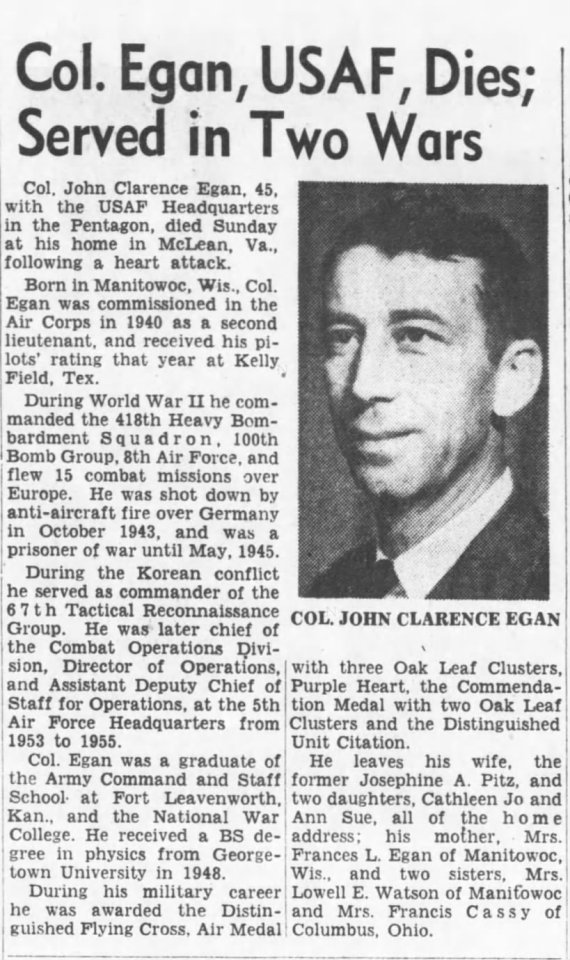

(Tumblr has made this one blurry - HD image via this link, but I have added the whole text to the image description if that is more convenient)
#masters of the air#mota#john egan#bucky egan#John “Bucky” C. Egan#John C. Egan#historical background#and fanfic goldmine if you want#BAMF Bucky#intelligent Bucky#highly competent Bucky#Bucky isn't stupid#Physics#Physics geek#(affectionate)
24 notes
·
View notes
Text
Main menu
Create account
Log in
Personal tools
Contents
(Top)
History
References
External links
Mug Root Beer
Article
Talk
Read
Edit
View history
Tools
From Wikipedia, the free encyclopedia
This article needs additional citations for verification. Please help improve this article by adding citations to reliable sources. Unsourced material may be challenged and removed.
Find sources: "Mug Root Beer" – news · newspapers · books · scholar · JSTOR(February 2013) (Learn how and when to remove this template message)Mug Root BeerProduct typeRoot beerOwnerPepsiCo 1986–presentProduced byNew Century Beverage Co.CountryU.S.Introduced1940; 83 years agoPrevious ownersBelfast Beverage Co.Websitepepsico.com/mugrootbeer
Mug Root Beer is an American brand of root beer that was originally produced in 1940 under the name Belfast Root Beer. It is now made by New Century Beverage Company of San Francisco, California, which was acquired by PepsiCo in 1986.[1][2]
History
Mug Root Beer was originally sold under the name Belfast Root Beer in 1940 by the Belfast Beverage Company in San Francisco, California. The company had been known for making sparkling water and ginger ale since 1877.[3] Belfast Beverage Company was purchased around 1925 by New Century Beverage Company, which had successfully launched Crush Soda in 1918.
In 1936, New Century Beverage Company gained permission to franchise Pepsi-Cola products, and about four years later, it launched Belfast Root Beer. An advertisement for Belfast Root Beer appears as early as 1947.[4] According to the San Francisco Examiner, the catchphrase, 'You haven’t tasted Root Beer like this in years!' filled 1950s newspaper advertisements."[3] An advertisement for Belfast Old Fashioned Mug Root Beer appears as early as 1952.[5] In the 1950s, the soda took on the title Belfast Old Fashioned Mug Root Beer before its name was eventually shortened to Mug Root Beer.[3]
In the late 1960s, Sugar Free Mug (now Diet Mug Root Beer) was introduced.[6] Mug Cream Soda and Diet Mug Cream Soda were later introduced, but they are not as widely available. Mug was purchased by Pepsi in 1986, and replaced On-Tap Draft Style Root Beer as Pepsi's root beer brand.[6] Mug Root Beer is manufactured by independent bottlers under the authority of New Century Beverage Company.
Since Mug Root Beer's acquisition by PepsiCo in 1986, the company's mascot has been a bulldog named "Dog" holding a mug of Mug Root Beer.[3] PepsiCo stopped producing its sodas in San Francisco in the early 1990s.[3]
References
"Mug Root Beer | PepsiCo Partners". www.pepsicopartners.com. Archived from the original on 2021-10-30. Retrieved 2021-12-28. "THE MEDIA BUSINESS - ADVERTISING - Lois Pitts Gershon Pon Wins Mug Root Beer - NYTimes.com". The New York Times. 2015-05-25. Archived from the original on 25 May 2015. Retrieved 2022-04-06. Guerrero, Susana (October 2, 2021). "The brief story of how one of America's favorite root beer brands started in San Francisco". SFGate. Archived from the original on March 13, 2022. Retrieved March 13, 2022. At that point, Mug Root Beer became part of the Pepsi family, which later got rid of the root beer vessel completely and opted for a bulldog — quirkily named "Dog" — as its new soda mascot. September 24, 1947, Bakersfield Californian, p. 7 (available at newspaperarchive.com) March 4, 1952, Mountain Democrat, p. 5 (available at newspaperarchive.com)
Mug Root Beer Archived 2013-11-27 at the Wayback Machine Retrieved August 22, 2012.
External links
Official website
MUG Trademark Update 72039315
BELFAST - Brand - NEW CENTURY BEVERAGE COMPANY SAN FRANCISCO, CA - Serial Number: 72284549
OLD FASHIONED MUG - Brand - BELFAST BEVERAGES, INC. SAN FRANCISCO , - Serial Number: 71602543
v
t
e
PepsiCo
v
t
e
Root beer
This soft drink–related article is a stub. You can help Wikipedia by expanding it.
Categories:
Root beer
PepsiCo soft drinks
PepsiCo brands
Food and drink in the San Francisco Bay Area
Soft drink stubs
This page was last edited on 5 July 2023, at 13:47 (UTC).
Text is available under the Creative Commons Attribution-ShareAlike License 4.0; additional terms may apply. By using this site, you agree to the Terms of Use and Privacy Policy. Wikipedia® is a registered trademark of the Wikimedia Foundation, Inc., a non-profit organization.
Privacy policy
About Wikipedia
Disclaimers
Contact Wikipedia
Code of Conduct
Mobile view
Developers
Statistics
Cookie statement
6 notes
·
View notes
Text
A Moment in U.S. History
In May of 1944, from the point of view of anyone in the U.S.'s general population, the outcome of World War II was unknown. If the Allied generals could predict the war's outcome, they were not sharing any such information about what was happening in Europe, in North Africa, in the Pacific, and in Asia with journalists. The information that was shared could not be turned into a prediction.
In May of 1944, one of Hollywood's major studios, Warner Brothers, released to theaters a movie called BETWEEN TWO WORLDS, an adaptation of a play called "Outward Bound" that debuted in London, the United Kingdom, in 1923. In my humble opinion, the movie was created to boost the morale of the general public. It was a way for people in the U.S. to hope for a good end to the war.
The movie's debut occurred some six years prior to my birth.
Starting in the late 1950s, throughout the 1960s, and into the 1970s, BETWEEN TWO WORLDS was shown, from time to time, throughout the U.S. on television stations. In the 1980s, the country gradually started getting wired for cable television and, as that progressed, fewer and fewer tv stations programmed movies from the 1930s and 1940s. Many of those movies are now forgotten.
I don't recall ever spotting BETWEEN TWO WORLDS in a newspaper's tv listings. However, recently, I have watched the movie three times on DVD. My intention, with this piece at Tumblr, is to share my thoughts and observations about how the movie boosted the morale of the general public.
BETWEEN TWO WORLDS initially presents a group of eight characters waiting in a shipping company's large ground floor office, amongst a larger group of characters, for permission to take a taxicab to the docks of an unnamed English port city where they can board a ship that will sail to the U.S. This is taking place in 1944.
A ninth character attempts to join the others but is not permitted to do so, owing to British government travel policies during wartime.
A German air force bombing raid starts up and the various characters in the shipping company's large waiting room scatter, desperate for safety. The group of eight characters start for the docks in a taxicab. The cab is hit directly by a bomb dropped by a German plane.
The bulk of the movie's plot plays out on a boat that symbolizes a journey or process. The ship's journey or process is for all human beings, once they die, a journey and process that ends up in either heaven or in hell.
Two characters, arriving on board separately from the group of eight, know that they have died. The group of eight characters who got into the taxicab do not know that they have died.
As a rule, I don't try to give away the bulk of a movie's plot and, in the case of BETWEEN TWO WORLDS, I haven't. That's because the bulk of the movie's plot details the way in which the individual characters deal with the knowledge of their death and the way in which they wind up in either heaven or hell. I'm referring to ten characters.
It's that part of the plot that should interest movie lovers the most -- here, years later -- about BETWEEN TWO WORLDS as an experience.
But to continue with what I have written so far, I have to pose a question.
What were people in general in the U.S. -- specifically adults -- concerned about regarding progress in the war?
It's a subject that I did not hear addressed in documentaries or read about in history books, when I was younger. I did learn a little about an organized war bonds effort that supported the U.S. armed forces. That's all I remember.
My father and mother (born 1917 and 1920, respectively) shared their memories of what they did during the war years, occasionally. But as for describing what people in general talked about or did in their spare time, once the U.S. declared war, they said nothing. They encouraged my brother and I to read and watch documentaries. Which we did.
Fiction narrative, shot on film whether comedy or drama, has to be added to this subject. BETWEEN TWO WORLDS is a contemporary drama. By simply paying attention to everything that happens on screen, I can guess the way in which adults at the time appreciated the movie.
For starters, I'm guessing that the year 1944 was the begining of an uptick, an increase in the number of people leaving Europe to travel to the U.S. Most of these people had been uprooted or displaced by the war.
In the movie, the ten characters -- the group of eight, joined by the two characters who knew they were dead -- were American, British, Irish, and Austrian. Most of them were educated. The British characters were not uprooted or displaced; they wanted to get to safety to wait for the war to end.
The adults in the movie theater audience regarded all ten characters as easy to understand and relatable, in terms of their personalities, their backgrounds, and their motivations.
And as the audience watched the plot play out, undoubtedly many adults thought about people who they knew, people from their lives. Family members might be serving overseas. A relative might be serving overseas. A neighbor's family member might be serving overseas. A co-worker's family member might be serving overseas. Were they ever going to return? How would any of these people in the audience deal with their family member's or relative's or friend's deaths?
The lack of any specific information about what was happening overseas had to lead to a great deal of anxiety.
In the movie, that anxiety is addressed by the arrival of a new character on board, the Examiner, who talks to each of the group of eight characters. His conversation helps each character deal with whether they proceed to heaven or to hell.
I'm wondering about how well BETWEEN TWO WORLDS did at the box office. Depending on an individual adult's background, the movie, at its conclusion, helped the audience to accept the fact that people near and dear to them might not make it home from their service overseas.
I'm not recommending BETWEEN TWO WORLDS to movie lovers at Tumblr, but if any of this sounds interesting, then the movie is available on DVD.
-- Drew Simels
1 note
·
View note
Text

Colleen Moore (born Kathleen Morrison; August 19, 1899 – January 25, 1988) was an American film actress who began her career during the silent film era. Moore became one of the most fashionable (and highly-paid) stars of the era and helped popularize the bobbed haircut.
A huge star in her day, approximately half of Moore's films are now considered lost, including her first talking picture from 1929. What was perhaps her most celebrated film, Flaming Youth (1923), is now mostly lost as well, with only one reel surviving.
Moore took a brief hiatus from acting between 1929 and 1933, just as sound was being added to motion pictures. After the hiatus, her four sound pictures released in 1933 and 1934 were not financial successes. Moore then retired permanently from screen acting.
After her film career, Moore maintained her wealth through astute investments, becoming a partner of Merrill Lynch. She later wrote a "how-to" book about investing in the stock market.
Moore also nurtured a passion for dollhouses throughout her life and helped design and curate The Colleen Moore Dollhouse, which has been a featured exhibit at the Museum of Science and Industry in Chicago, Illinois since the early 1950s. The dollhouse, measuring 9 square feet (0.84 m2), was estimated in 1985 to be worth of $7 million, and it is seen by 1.5 million people annually.
Moore was born Kathleen Morrison on August 19, 1899, (according to the bulk of the official records;[4] the date which she insisted was correct in her autobiography, Silent Star, was 1902)[5] in Port Huron, Michigan,[6] Moore was the eldest child of Charles R. and Agnes Kelly Morrison. The family remained in Port Huron during the early years of Moore's life, at first living with her grandmother Mary Kelly (often spelled Kelley) and then with at least one of Moore's aunts.
By 1905, the family moved to Hillsdale, Michigan, where they remained for over two years. They relocated to Atlanta, Georgia, by 1908. They are listed at three different addresses during their stay in Atlanta (From the Atlanta-Fulton Public Library city directories): 301 Capitol Avenue −1908; 41 Linden Avenue – 1909; 240 N. Jackson Street – 1910. They then lived briefly — probably less than a year — in Warren, Pennsylvania, and by 1911, they had settled in Tampa, Florida.
At age 15 she was taking her first step in Hollywood. Her uncle arranged a screen test with director D.W. Griffith. She wanted to be a second Lillian Gish but instead, she found herself playing heroines in Westerns with stars such as Tom Mix.
Two of Moore's great passions were dolls and movies; each would play a great role in her later life. She and her brother began their own stock company, reputedly performing on a stage created from a piano packing crate. Her aunts, who doted on her, indulged her other great passion and often bought her miniature furniture on their many trips, with which she furnished the first of a succession of dollhouses. Moore's family summered in Chicago, where Moore enjoyed baseball and the company of her Aunt Lib (Elizabeth, who changed her name to "Liberty", Lib for short) and Lib's husband Walter Howey. Howey was the managing editor of the Chicago Examiner and an important newspaper editor in the publishing empire of William Randolph Hearst, and was the inspiration for Walter Burns, the fictional Chicago newspaper editor in the play and the film, The Front Page.
Early years
Essanay Studios was within walking distance of the Northwestern L, which ran right past the Howey residence. (They occupied at least two residences between 1910 and 1916: 4161 Sheridan and 4942 Sheridan.) In interviews later in her silent film career, Moore claimed she had appeared in the background of several Essanay films, usually as a face in a crowd. One story has it she had gotten into the Essanay studios and waited in line to be an extra with Helen Ferguson: in an interview with Kevin Brownlow many years later, Ferguson told a story that substantially confirmed many details of the claim, though it is not certain if she was referring to Moore's stints as a background extra (if she really was one) or to her film test there prior to her departure for Hollywood in November 1917. Film producer D.W. Griffith was in debt to Howey, who had helped him to get both The Birth of a Nation and Intolerance through the Chicago censorship board.
"I was being sent to Hollywood - not because anybody out there thought I was any good, but simply to pay off a favor".
The contract to Griffith's Triangle-Fine Arts was conditional on passing a film test to ensure that her heterochromia (she had one brown eye, one blue eye) would not be a distraction in close-up shots. Her eyes passed the test, so she left for Hollywood with her grandmother and her mother as chaperones. Moore made her first credited film appearance in 1917 in The Bad Boy for Triangle Fine Arts, and for the next few years appeared in small, supporting roles gradually attracting the attention of the public.
The Bad Boy was released on February 18, and featured Robert Harron, Richard Cummings, Josephine Crowell, and Mildred Harris (who would later become Charles Chaplin's first wife). Two months later, it was followed by An Old-Fashioned Young Man, again with Robert Harron. Moore’s third film was Hands Up! filmed in part in the vicinity of the Seven Oaks (a popular location for productions that required dramatic vistas). This was her first true western. The film’s scenario was written by Wilfred Lucas from a story by Al Jennings, the famous outlaw who had been freed from jail by presidential pardon by Theodore Roosevelt in 1907. Monte Blue was in the cast and noticed Moore could not mount her horse, though horseback riding was required for the part (during casting for the part she neglected to mention she did not know how to ride). Blue gave her a quick lesson essentially consisting of how to mount the horse and how to hold on.
On May 3, 1917, the Chicago Daily Tribune said: "Colleen Moore contributes some remarkable bits of acting. She is very sweet as she goes trustingly to her bandit hero, and, O, so pitiful, when finally realizing the character of the man, she goes into a hysteria of terror, and, shrieking 'Daddy, Daddy, Daddy!' beats futilely on a bolted door, a panic-stricken little human animal, who had not known before that there was aught but kindness in the world." About the time her first six-month contract was extended an additional six months, she requested and received a five weeks release to do a film for Universal's Bluebird division, released under the name The Savage. This was her fourth film, and she was only needed for two weeks. Upon her return to the Fine Arts lot, she spent several weeks trying to get her to pay for the three weeks she had been available for work for Triangle (finally getting her pay in December of that year).
Soon after, the Triangle Company went bust, and while her contract was honored, she found herself scrambling to find her next job. With a reel of her performance in Hands Up! under her arm, Colin Campbell arranged for her to get a contract with Selig Polyscope. She was very likely at work on A Hoosier Romance before The Savage was released in November. After A Hoosier Romance, she went to work on Little Orphant Annie. Both films were based upon poems by James Whitcomb Riley, and both proved to be very popular. It was her first real taste of popularity.
Little Orphant Annie was released in December. The Chicago Daily Tribune wrote of Moore, "She was a lovely and unspoiled child the last time I saw her. Let’s hope commendation hasn’t turned her head." Despite her good notices, her luck took a turn for the worse when Selig Polyscope went bust. Once again Moore found herself unemployed, but she had begun to make a name for herself by 1919. She had a series of films lined up. She went to Flagstaff, Arizona for location work on The Wilderness Trail, another western, this time with Tom Mix. Her mother went along as a chaperone. Moore wrote that while she had a crush on Mix, he only had eyes for her mother. The Wilderness Trail was a Fox Film Corporation production, and while it had started production earlier, it would not be released until after The Busher, which was released on May 18. The Busher was an H. Ince Productions-Famous Players-Lasky production; it was a baseball film wherein the hero was played by John Gilbert. The Wilderness Trail followed on July 6, another Fox film. A few weeks later, The Man in the Moonlight, a Universal Film Manufacturing Company film was released on July 28. The Egg Crate Wallop was a Famous Players-Lasky production released by Paramount Pictures on September 28.
The next stage of her career was with the Christie Film Company, a move she made when she decided she needed comic training. While with Christie, she made Her Bridal Nightmare, A Roman Scandal, and So Long Letty. At the same time as she was working on these films, she worked on The Devil's Claim with Sessue Hayakawa, in which she played a Persian woman, When Dawn Came, and His Nibs (1921) with Chic Sale. All the while, Marshall Neilan had been attempting to get Moore released from her contract so she could work for him. He was successful and made Dinty with Moore, releasing near the end of 1920, followed by When Dawn Came.
For all his efforts to win Moore away from Christie, it seems Neilan loaned Moore to other studios most of the time. He loaned her out to King Vidor for The Sky Pilot, released in May 1921, yet another Western. After working on The Sky Pilot on location in the snows of Truckee, she was off to Catalina Island for work on The Lotus Eater with John Barrymore. In October 1921, His Nibs was released, her only film to be released that year besides The Sky Pilot. In His Nibs, Moore actually appeared in a film within the film; the framing film was a comedy vehicle for Chic Sales. The film it framed was a spoof on films of the time. 1922 proved to be an eventful year for Moore as she was named a WAMPAS Baby Star during a "frolic" at the Ambassador Hotel which became an annual event, in recognition of her growing popularity.[13] In early 1922, Come On Over was released, made from a Rupert Hughes story and directed by Alfred E. Green. Hughes directed Moore himself in The Wallflower, released that same year. In addition, Neilan introduced her to John McCormick, a publicist who had had his eye on Moore ever since he had first seen her photograph. He had prodded Marshall into an introduction. The two hit it off, and before long they were engaged. By the end of that year, three more of her films were released: Forsaking All Others, The Ninety and Nine, and Broken Chains.
Look Your Best and The Nth Commandment were released in early 1923, followed by two Cosmopolitan Productions, The Nth Commandment and Through the Dark. By this time, Moore had publicly confirmed her engagement to McCormick, a fact that she had been coy about to the press previously. Before mid-year, she had signed a contract with First National Pictures, and her first two films were slated to be The Huntress and Flaming Youth. Slippy McGee came out in June, followed by Broken Hearts of Broadway.
Moore and John McCormick married while Flaming Youth was still in production, and just before the release of The Savage. When it was finally released in 1923, Flaming Youth, in which she starred opposite actor Milton Sills, was a hit. The controversial story put Moore in focus as a flapper, but after Clara Bow took the stage in Black Oxen in December, she gradually lost her momentum. In spring 1924 she made a good but unsuccessful effort to top Bow in The Perfect Flapper, and soon after she dismissed the whole flapper vogue; "No more flappers...people are tired of soda-pop love affairs." Decades later Moore stated Bow was her "chief rival."
Through the Dark, originally shot under the name Daughter of Mother McGinn, was released during the height of the Flaming Youth furor in January 1924. Three weeks later, Painted People was released. After that, she was to star in Counterfeit. The film went through a number of title changes before being released as Flirting with Love in August. In October, First National purchased the rights to Sally for Moore's next film. It would be a challenge, as Sally was a musical comedy. In December, First National purchased the rights to Desert Flower and in so doing had mapped out Moore's schedule for 1925: Sally would be filmed first, followed by The Desert Flower.
By the late 1920s, she had accomplished dramatic roles in films such as So Big, where Moore aged through a stretch of decades, and was also well received in light comedies such as Irene. An overseas tour was planned to coincide with the release of So Big in Europe, and Moore saw the tour as her first real opportunity to spend time with her husband, John McCormick. Both she and John McCormick were dedicated to their careers, and their hectic schedules had kept them from spending any quality time together. Moore wanted a family; it was one of her goals.
Plans for the trip were put in jeopardy when she injured her neck during the filming of The Desert Flower. Her injury forced the production to shut down while Moore spent six weeks in a body cast in bed. Once out of the cast, she completed the film and left for Europe on a triumphal tour. When she returned, she negotiated a new contract with First National. Her films had been great hits, so her terms were very generous. Her first film upon her return to the States was We Moderns, set in England with location work done in London during the tour. It was a comedy, essentially a retelling of Flaming Youth from an English perspective. This was followed by Irene (another musical in the style of the very popular Sally) and Ella Cinders, a straight comedy that featured a cameo appearance by comedian Harry Langdon. It Must Be Love was a romantic comedy with dramatic undertones, and it was followed by Twinkletoes, a dramatic film that featured Moore as a young dancer in London's Limehouse district during the previous century. Orchids and Ermine was released in 1927, filmed in part in New York, a thinly veiled Cinderella story.
In 1927, Moore split from her studio after her husband suddenly quit. It is rumored that John McCormick was about to be fired for his drinking and that she left as a means of leveraging her husband back into a position at First National. It worked, and McCormick found himself as Moore's sole producer. Moore's popularity allowed her productions to become very large and lavish. Lilac Time was one of the bigger productions of the era, a World War I drama. A million dollar film, it made back every penny spent within months. Prior to its release, Warner Bros. had taken control of First National and were less than interested in maintaining the terms of her contract until the numbers started to roll in for Lilac Time. The film was such a hit that Moore managed to retain generous terms in her next contract and her husband as her producer.
In 1928, inspired by her father and with help from her former set designer, a dollhouse was constructed by her father, which was 9 square feet with the tallest tower 12 feet high. The interior of The Colleen Moore Dollhouse, designed by Harold Grieve, features miniature bear skin rugs and detailed furniture and art. Moore's dollhouse has been a featured exhibit at the Museum of Science and Industry in Chicago, Illinois since October 30, 1949, where according to the museum, it is seen by 1.5 million people each year and would be worth $7 million. Moore continued working on it and contributing artifacts to it until her death.
This dollhouse was the eighth one Moore owned. The first dollhouse, she wrote in her autobiography Silent Star (1968), evolved from a cabinet that held her collection of miniature furniture. It was supposedly built from a cigar box. Kitty Lorgnette wrote in the Saturday, August 13, 1938 edition of The Evening News (Tampa) that the first dollhouse was purchased by Oraleze O'Brien (Mrs. Frank J. Knight) in 1916 when Moore (then Kathleen) left Tampa. Oraleze was too big for dollhouses, however, and she sold it again after her cat had kittens in it, and from there she lost track of it. The third house was possibly given to the daughter of Moore's good friend, author Adela Rogers St. Johns. The fourth survives and remains on display in the living room of a relative.
With the advent of talking pictures in 1929, Moore took a hiatus from acting. After divorcing McCormick in 1930, Moore married prominent New York-based stockbroker Albert Parker Scott in 1932. The couple lived at that time in a lavish home at 345 St. Pierre Road in Bel Air, where they hosted parties for and were supporters of the U.S. Olympic team, especially the yachting team, during the 1932 Summer Olympics held in Los Angeles.
In 1934, Moore, by then divorced from Albert Parker Scott, returned to work in Hollywood. She appeared in three films, none of which was successful, and Moore retired. Her last film was a version of The Scarlet Letter in 1934. She later married the widower Homer Hargrave and raised his children (she never had children of her own) from a previous marriage, with whom she maintained a lifelong close relationship. Throughout her life she also maintained close friendships with other colleagues from the silent film era, such as King Vidor and Mary Pickford.
In the 1960s, Moore formed a television production company with King Vidor with whom she had worked in the 1920s. She also published two books in the late 1960s, her autobiography Silent Star: Colleen Moore Talks About Her Hollywood (1968) and How Women Can Make Money in the Stock Market (1969). She also figures prominently alongside King Vidor in Sidney D. Kirkpatrick's book, A Cast of Killers, which recounts Vidor's attempt to make a film of and solve the murder of William Desmond Taylor. In that book, she is recalled as having been a successful real estate broker in Chicago and partner in the investment firm Merrill Lynch after her film career.
Many of Moore's films deteriorated, but not due to her own neglect, after she had sent them to be preserved at the Museum of Modern Art. Some time later, Warner Brothers asked for their nitrate materials to be returned to them. Moore's earlier First National films were also sent, since Warners later acquired First National. Upon their arrival, the custodian at MOMA, not seeing the films on the manifest, put them to one side and never went back to them. Many years later, Moore inquired about her collection and MOMA found the films languishing unprotected. When the films were examined, they had decomposed past the point of preservation. Heartbroken, she tried in vain to retrieve any prints she could from several sources without much success. In 1956, the material from WB and FN was sold to Associated Artists Productions, later to MGM/UA and then, Turner Entertainment.
At the height of her fame, Moore was earning $12,500 per week. She was an astute investor, and through her investments, remained wealthy for the rest of her life. In her later years she would frequently attend film festivals, and was a popular interview subject always willing to discuss her Hollywood career. She was a participant in the documentary series Hollywood (1980), providing her recollections of Hollywood's silent film era.
Moore was married four times. Her first marriage was to John McCormick of First National Studios. They married in 1923 and divorced in 1930. In 1932, Moore married stockbroker Albert P. Scott. This union ended in divorce in 1934. Moore's third marriage was to Homer Hargrave, whom she married in 1936; he provided funding for her dollhouse and she adopted his son, Homer Hargrave, Jr and his daughter, Judy Hargrave. They remained married until Hargrave's death in 1965. In 1982, Moore married her final husband, builder Paul Magenot. They were married until Moore's death in 1988.
On January 25, 1988, Moore died from cancer in Paso Robles, California, aged 88. For her contribution to the motion picture industry, Colleen Moore has a star on the Hollywood Walk of Fame at 1551 Vine Street.
F. Scott Fitzgerald wrote of her: "I was the spark that lit up Flaming Youth, Colleen Moore was the torch. What little things we are to have caused all that trouble."
#colleen moore#silent era#silent hollywood#silent movie stars#1910s movies#1920s hollywood#golden age of hollywood#classic movie stars#classic hollywood#1930s hollywood#flapper#roaring 20s
22 notes
·
View notes
Text
LUCILLE & DESI SOLVE A PARENT PROBLEM
November 22, 1952

Lucille Ball and Desi Arnaz were on the cover of TV Digest for the week of November 22, 1952. The inside article was titled “Lucille and Desi Solve a Parent Problem.”

“With a baby due in January, how does the show stay on the air?”
The article reveals that the past summer hiatus was spent ‘banking’ enough episodes of the show to last through March 1953. Using a photo of Lucy tumbling through an open window in “The Anniversary Present” (ILL S2;E3) aired on September 29, 1952 but filmed on May 9, 1952, the article asserts that physical comedy will be temporarily omitted from future episodes. A candid photo depicts Lucille and Desi relaxing with their infant daughter, Lucille Desiree.
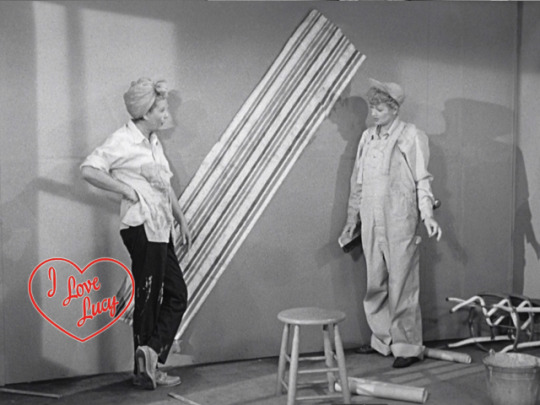
The inside listings include the original broadcast of “Redecorating” (ILL S2;E8) first aired on Monday, November 24, 1952. At the time of filming, Lucille Ball was already four months pregnant, although it was not yet part of the storyline on the show. To hide her condition, Lucy dressed in loose-fitting clothes throughout the episode. The big announcement would come two weeks later in “Lucy is Enceinte” (ILL S2;E10) aired on December 8, 1952.
IN OTHER NEWS...


Also on November 22, 1952, an Arlington Heights, Illinois, cinema offered a double bill of Cuban Pete (1944) starring Desi Arnaz and Lover Come Back (1946) starring Lucille Ball, which was retitled for its’ 1952 re-release Lucy Goes Wild to capitalize on the success of “I Love Lucy.” In the early 1950s cinemas were worried that competition from TV would make them obsolete.

The State Theatre in Richmond, Indiana, also wooed people away from the television into their popcorn palace, this time with second-run screenings of Look Who’s Talking (1941) and Too Many Girls (1940).
Nationwide, other cinemas were taking a similar tact with re-bookings of:
Fancy Pants (1950) in Bunkie, Louisiana and Hazleton, Pennsylvania
Sorrowful Jones (1949) in El Paso, Texas
A double bill of The Fuller Brush Man (1948) and The Fuller Brush Girl (1950) in Dorchester, Massachusetts
The Magic Carpet (1951) in Vancouver, British Columbia
Too Many Girls (1940) in Miami Beach, Florida
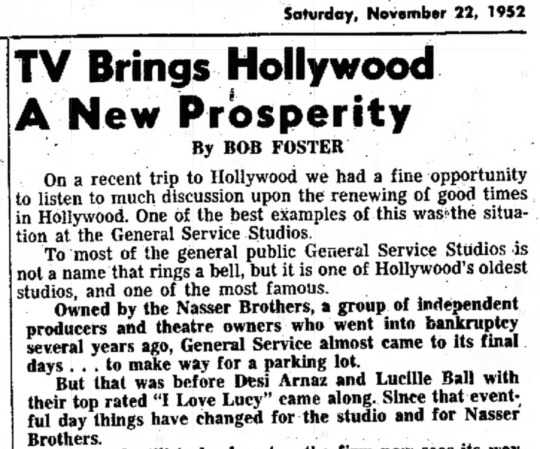
In a San Mateo, California, newspaper, Bob Foster credited the success of “I Love Lucy” with saving General Services Studios from bankruptcy.

Meanwhile, in Hawaii, one of Lucy and Desi’s favorite vacation spots, an appliance dealership in Honolulu was tempting potential viewers to buy a set in order to see “I Love Lucy” and other great shows when network television broadcasts finally arrived on the island in December 1952.

Groff’s Hardware in New Holland, Pennsylvania, took out a classified ad to let readers know they were selling the “I Love Lucy” baby doll.

Erkskine Johnson did a story on the ubiquitous laugh track, getting a quote from “I Love Lucy” DP Karl Freund.
SATURDAY’S SYNDICATED STORIES!


Lucy’s friend and future co-star Hedda Hopper claimed Lucy often wore ribbons in her hair, making her look like a Christmas tree. B. Kaper is composer Bronisław Kaper, who scored Without Love (1945) starring Lucille Ball and would also score Forever, Darling starring Lucy and Desi in 1956.
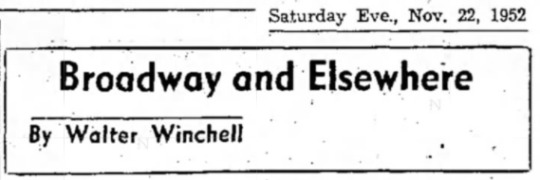

Walter Winchell’s “Broadway and Elsewhere” reported that the latest “I Love Lucy” episode was “30 minutes long and a smile wide...” There was no new episode the previous Monday (November 17, 1952), so Winchell must be referring to “The Courtroom” (ILL S2;E7) which aired on Monday, November 10, 1952.
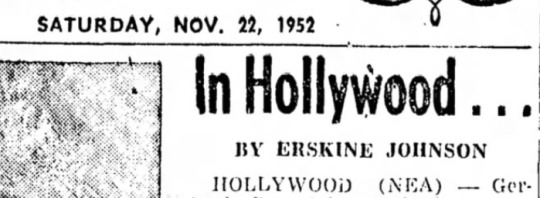
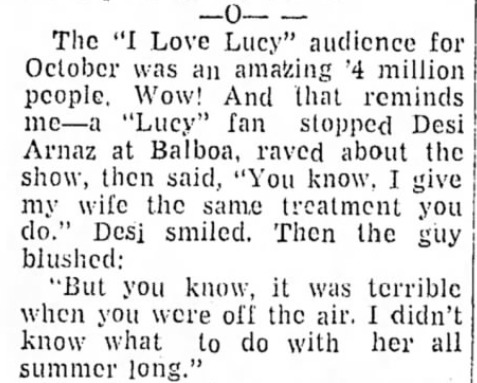
Erskine Johnson’s November 22, 1952, syndicated column “In Hollywood...” provided an anecdote about an “I Love Lucy” fan and the show’s record-setting viewership.

Dorothy Kilgallen’s syndicated column “Broadway: Gossip in Gotham” reported that Lucy and Desi were thinking about moving production of “I Love Lucy” to Cuba for tax reasons! As history knows, this never happened and sounds highly unlikely knowing Desi’s patriotic love of the USA.

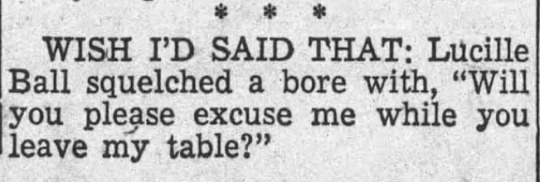
Earl Wilson’s November 22, 1952 syndicated column “It Happened Last Night” closed with a barb attributed to Lucille Ball: “Will you please excuse me while you leave my table?”
#Lucille Ball#1952#TV Digest#I Love Lucy#Desi Arnaz#Earl Wilson#Dorothy Kilgallen#Hedda Hopper#Erskine Johnson#Walter Winchell#TV
7 notes
·
View notes
Text
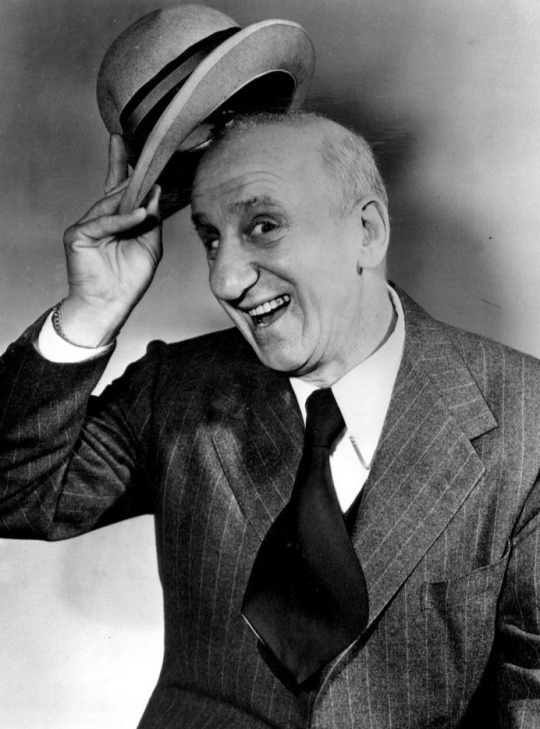
James Francis Durante (February 10, 1893 – January 29, 1980) was an American actor, comedian, singer, and pianist. His distinctive gravelly speech, Lower East Side accent, comic language-butchery, jazz-influenced songs, and prominent nose helped make him one of America's most familiar and popular personalities of the 1920s through the 1970s. He often referred to his nose as the schnozzola (Italianization of the American Yiddish slang word schnoz "big nose"), and the word became his nickname.
Durante was born on the Lower East Side of New York City. He was the youngest of four children born to Rosa (Lentino) and Bartolomeo Durante, both of whom were immigrants from Salerno, Italy. Bartolomeo was a barber. Young Jimmy served as an altar boy at St. Malachy Roman Catholic Church, known as the Actor's Chapel.
Durante dropped out of school in seventh grade to become a full-time ragtime pianist. He first played with his cousin, whose name was also Jimmy Durante. It was a family act, but he was too professional for his cousin. He continued working the city's piano bar circuit and earned the nickname "ragtime Jimmy", before he joined one of the first recognizable jazz bands in New York, the Original New Orleans Jazz Band. Durante was the only member not from New Orleans. His routine of breaking into a song to deliver a joke, with band or orchestra chord punctuation after each line, became a Durante trademark. In 1920 the group was renamed Jimmy Durante's Jazz Band.
By the mid-1920s, Durante had become a vaudeville star and radio personality in a trio named Clayton, Jackson and Durante. Lou Clayton and Eddie Jackson, Durante's closest friends, often reunited with Durante in subsequent years. Jackson and Durante appeared in the Cole Porter musical The New Yorkers, which opened on Broadway on December 8, 1930. Earlier the same year, the team appeared in the movie Roadhouse Nights, ostensibly based on Dashiell Hammett's novel Red Harvest.
By 1934, Durante had a major record hit with his own novelty composition, "Inka Dinka Doo", with lyrics by Ben Ryan. It became his theme song for the rest of his life. A year later, Durante starred on Broadway in the Billy Rose stage musical Jumbo. A scene in which a police officer stopped Durante's character—who was leading a live elephant across the stage—to ask "what are you doing with that elephant?", followed by Durante's reply "what elfin!?" was a regular show-stopper. This comedy bit, also reprised in his role in Billy Rose's Jumbo, likely contributed to the popularity of the idiom "the elephant in the room". Durante also appeared on Broadway in Show Girl (1929), Strike Me Pink (1934) and Red, Hot and Blue (1936).
During the early 1930s, Durante alternated between Hollywood and Broadway. His early motion pictures included an original Rodgers & Hart musical The Phantom President (1932), which featured Durante singing the self-referential Schnozzola. He initially was paired with silent film legend Buster Keaton in a series of three popular comedies for Metro-Goldwyn-Mayer, Speak Easily (1932), The Passionate Plumber (1932), and What! No Beer? (1933), which were financial hits and a career springboard for the distinctive newcomer. However, Keaton's vociferous dissatisfaction with constraints the studio had placed upon him, his perceived incompatibility with Durante's broad chatty humor, exacerbated by Keaton's alcoholism, led the studio to end the series. Durante went on to appear in The Wet Parade (1932), Broadway to Hollywood (1933), The Man Who Came to Dinner (1942, playing Banjo, a character based on Harpo Marx), Ziegfeld Follies (1946), Billy Rose's Jumbo (1962, based on the 1935 musical), and It's a Mad, Mad, Mad, Mad World (1963). In 1934, he starred in Hollywood Party, where he dreams he is Schnarzan, a parody of Tarzan, who was popular at the time due to the Johnny Weissmuller films.
On September 10, 1933, Durante appeared on Eddie Cantor's NBC radio show, The Chase and Sanborn Hour, continuing until November 12 of that year. When Cantor left the show, Durante took over as its star from April 22 to September 30, 1934. He then moved on to The Jumbo Fire Chief Program (1935–1936).
Durante teamed with Garry Moore for The Durante-Moore Show in 1943. Durante's comic chemistry with the young, brushcut Moore brought Durante an even larger audience. "Dat's my boy dat said dat!" became an instant catchphrase, which would later inspire the cartoon Augie Doggie and Doggie Daddy. The duo was one of the nation's favorites for the rest of the decade. Their Armed Forces Radio Network Command Performance with Frank Sinatra remains a favorite of radio-show collectors today. Moore left the duo in mid-1947, and the program returned October 1, 1947 as The Jimmy Durante Show. Durante continued the show for three more years and featured a reunion of Clayton, Jackson and Durante on his April 21, 1948 broadcast.
Although Durante made his television debut on November 1, 1950 (on the Four Star Revue - see below) he continued to keep a presence in radio, as a frequent guest on Tallulah Bankhead's two-year NBC comedy-variety show The Big Show. Durante was one of the cast on the show's premiere November 5, 1950, along with humorist Fred Allen, singers Mindy Carson and Frankie Laine, stage musical performer Ethel Merman, actors Jose Ferrer and Paul Lukas, and comic-singer Danny Thomas (about to become a major television star in his own right). A highlight of the premiere was Durante and Thomas, whose own nose rivaled Durante's, in a routine in which Durante accused Thomas of stealing his nose. "Stay outta dis, no-nose!" Durante barked at Bankhead to a big laugh.
From 1950 to 1951, Durante was the host once a month (alternating with Ed Wynn, Danny Thomas and Jack Carson) on Wednesday evenings at 8 p.m, on NBC's comedy-variety series Four Star Revue. Jimmy continued with the show until 1954.
Durante then had a half-hour variety show - The Jimmy Durante Show - on NBC from October 2, 1954 to June 23, 1956.
Beginning in the early 1950s, Durante teamed with sidekick Sonny King, a collaboration that would continue until Durante's death. He often was seen regularly in Las Vegas after Sunday Mass outside of the Guardian Angel Cathedral standing next to the priest and greeting the people as they left Mass.
Several times in the 1960s, Durante served as host of ABC's Hollywood Palace variety show, which was taped live (and consequently included ad-libs by the seasoned vaudevillian).
His last regular television appearance was co-starring with the Lennon Sisters on Jimmy Durante Presents the Lennon Sisters Hour, which lasted for one season on ABC (1969–1970).
Durante's first wife was Jean "Jeanne" Olson, whom he married on June 19, 1921. She was born in Ohio on August 31, 1896. She was 46 years old when she died on Valentine's Day in 1943, after a lingering heart ailment of about two years, although different newspaper accounts of her death suggest she was 45 or perhaps 52.[9] As her death was not immediately expected, Durante was touring in New York at the time and returned to Los Angeles right away to complete the funeral arrangements.
Durante's radio show was bracketed with two trademarks: "Inka Dinka Doo" as his opening theme, and the invariable signoff that became another familiar national catchphrase: "Good night, Mrs. Calabash, wherever you are." For years no one knew who Mrs. Calabash referred to and Durante preferred to keep the mystery alive until 1966. One theory was that it referred to the owner of a restaurant in Calabash, North Carolina, where Durante and his troupe had stopped to eat. He was so taken by the food, the service, and the chitchat he told the owner that he would make her famous. Since he did not know her name, he referred to her as "Mrs. Calabash". At a National Press Club meeting in 1966 (broadcast on NBC's Monitor program), Durante finally revealed that it was indeed a tribute to his wife. While driving across the country, they stopped in a small town called Calabash, North Carolina whose name Jean had loved. "Mrs. Calabash" became his pet name for her, and he signed off his radio program with "Good night, Mrs. Calabash." He added "wherever you are" after the first year.
Durante married his second wife, Margaret "Margie" Little, at St. Malachy Roman Catholic Church in New York City on December 14, 1960. As a teenager she had been crowned Queen of the New Jersey State Fair. She attended New York University before being hired by the legendary Copacabana in New York City. She and Durante met there 16 years before their marriage, when he performed there and she was a hatcheck girl. She was 41 and he 67 when they married. With help from their attorney, Mary G. Rogan, the couple were able to adopt a baby, Cecilia Alicia (nicknamed CeCe and now known as CeCe Durante-Bloum), on Christmas Day, 1961. CeCe became a champion horsewoman and then a horse trainer and horseriding instructor. Margie died on June 7, 2009, at the age of 89.
On August 15, 1958, for his charitable acts, Durante was awarded a three-foot-high brass loving cup by the Al Bahr Shriners Temple. The inscription reads: "JIMMY DURANTE THE WORLD'S MOST FAMOUS COMEDIAN. A loving cup to you Jimmy, it's larger than your nose, but smaller than your heart. Happiness always, Al Bahr Temple, August 15, 1958." Jimmy Durante started out his career with Clayton and Jackson and when he became a big star and they were left behind, he kept them on his payroll for the rest of their lives.
Durante's love for children continued through the Fraternal Order of Eagles, who among many causes raise money for handicapped and abused children. At Durante's first appearance at the Eagles International Convention in 1961, Judge Bob Hansen inquired about his fee for performing. Durante replied, "Do not even mention money judge or I'll have to mention a figure that'll make ya sorry ya brought it up." "What can we do then?" asked Hansen. "Help da kids," was Durante's reply. Durante performed for many years at Eagles conventions free of charge, even refusing travel money. The Fraternal Order of Eagles changed the name of their children's fund to the Jimmy Durante Children's Fund in his honor, and in his memory have raised over 20 million dollars to help children. A reporter once remarked of Durante after an interview: "You could warm your hands on this one." One of the projects built using money from the Durante Fund was a heated therapy swimming pool at the Hughen School in Port Arthur, Texas. Completed in 1968, Durante named the pool the "Inka Dinka Doo Pool".
Durante was an active member of the Democratic Party. In 1933, he appeared in an advertisement shown in theaters supporting Franklin D. Roosevelt's New Deal programs and wrote a musical score titled Give a Man a Job to accompany it. He performed at both the inaugural gala for President John F. Kennedy in 1961 and a year later at the famous Madison Square Garden rally for the Democratic party that featured Marilyn Monroe singing "Happy Birthday" to JFK.
Durante continued his film appearances through It's a Mad, Mad, Mad, Mad World and television appearances through the early 1970s. He narrated the Rankin-Bass animated Christmas special Frosty the Snowman (1969), re-run for many years since. The television work also included a series of commercial spots for Kellogg's Corn Flakes cereals in the mid-1960s, which introduced Durante's gravelly growl and narrow-eyed, large-nosed countenance to millions of children. "Dis is Jimmy Durante, in puy-son!" was his introduction to some of the Kellogg's spots. One of his last appearances was in a memorable television commercial for the 1973 Volkswagen Beetle, where he proclaimed that the new, roomier Beetle had "plenty of breathin' room... for de old schnozzola!"
In 1963, Durante recorded the album of pop standards September Song. The album became a best-seller and provided Durante's re-introduction to yet another generation, almost three decades later. From the Jimmy Durante's Way of Life album came the gravelly interpretation of the song "As Time Goes By", which accompanied the opening credits of the romantic comedy hit Sleepless in Seattle, while his version of "Make Someone Happy" launched the film's closing credits. Both are included on the film's best-selling soundtrack. Durante also recorded a cover of the well-known song I'll Be Seeing You, which became a trademark song on his 1960s TV show. This song was featured in the 2004 film The Notebook.
He wrote a foreword for a humorous book compiled by Dick Hyman titled Cockeyed Americana. In the first paragraph of the "Foreword!", as Durante called it, he describes meeting Hyman and discussing the book and the contribution that Hyman wanted Durante to make to it. Durante wrote "Before I can say gaziggadeegasackeegazobbath, we're at his luxurious office." After reading the material Hyman had compiled for the book, Durante commented on it: "COLOSSAL, GIGANTIC, MAGNANIMOUS, and last but not first, AURORA BOREALIS. [Capitalization Durante's] Four little words that make a sentence—and a sentence that will eventually get me six months."
Durante retired from performing in 1972 after he became wheelchair-bound following a stroke. He died of pneumonia in Santa Monica, California on January 29, 1980, 12 days before he would have turned 87. He received Catholic funeral rites four days later, with fellow entertainers including Desi Arnaz, Ernest Borgnine, Marty Allen, and Jack Carter in attendance, and was interred at Holy Cross Cemetery in Culver City, California.
On June 25, 2019, The New York Times Magazine listed Jimmy Durante among hundreds of artists whose material was reportedly destroyed in the 2008 Universal fire.
Jimmy Durante is known to most modern audiences as the character who narrated and sang the 1969 animated special Frosty the Snowman. He also performed the Ron Goodwin title song to the 1968 comedy-adventure Monte Carlo or Bust (titled Those Daring Young Men in Their Jaunty Jalopies in the U.S.) sung over the film's animated opening credits.
While his own career in animation was limited, Durante's distinctive voice, looks and catchphrases earned him numerous depictions and allusions in animation: A character in M-G-M cartoons, a bulldog named Spike, whose puppy son was always getting caught by accident in the middle of Tom and Jerry's activities, referenced Durante with a raspy voice and an affectionate "Dat's my boy!" In another Tom and Jerry short, a starfish lands on Tom's head, giving him a big nose. He then proceeds with Durante's famous "Ha-cha-cha-cha" call. The 1943 Tex Avery cartoon "What's Buzzin' Buzzard" featured a vulture with a voice that sounded like Jimmy Durante. A Durante-like voice (originally by Doug Young) was also given to the father beagle, Doggie Daddy, in Hanna-Barbera's Augie Doggie and Doggie Daddy cartoons, Doggie Daddy invariably addressing the junior beagle with a Durante-like "Augie, my son, my son", and with frequent citations of, "That's my boy who said that!" The 1945 MGM cartoon Jerky Turkey featured a turkey which was a caricature of Durante.
Many Looney Tunes/Merrie Melodies cartoons had characters based on Durante. One Harman-Ising short from 1933, Bosko's Picture Show, featured a caricature of Adolf Hitler chasing Durante with a meat cleaver. Two examples from the 1940s include A Gruesome Twosome, which features a cat based on Durante, and Baby Bottleneck, which in unedited versions opens with a Durante-like stork. Book Revue shows the well-known (at that time) 1924 Edna Ferber novel So Big featuring a Durante caricature on the cover. The "so big" refers to his nose, and as a runaway criminal turns the corner by the book, Durante turns sideways using his nose to trip the criminal, allowing his capture. In Hollywood Daffy, Durante is directly depicted as himself, pronouncing his catchphrase "Those are the conditions that prevail!" In The Mouse-Merized Cat, Catstello (a Lou Costello mouse) briefly is hypnotized to imitate Jimmy Durante singing Lullaby of Broadway. One of Durante's common catchphrases "I got a million of 'em!" was used as Bugs' final line in Stage Door Cartoon.
A Durante-like voice was also used for Marvel Comics superhero The Thing in the Hanna-Barbera cartoon Fred and Barney Meet the Thing. The voice and appearance of Crispy, the mascot for Crispy Critters cereal, was also based on Durante.[17] In Mickey Mouse Works, a character named Mortimer Mouse (voiced by Maurice LaMarche) was based on Durante, complete with the "ha-cha-cha!". One of the main characters in Terrytoons' Heckle and Jeckle cartoon series also takes to imitating Jimmy in 1948's "Taming The Cat" ("Get a couple of song birds today...").
Since Durante's death, his songs have featured in several films. Dan Aykroyd and Kim Basinger performed impressions of Durante from The Man Who Came to Dinner singing "Did You Ever Have the Feeling" in 1988's My Stepmother Is an Alien. His performance of "Young at Heart" was featured in City Slickers (1991) and his versions of "As Time Goes By" and "Make Someone Happy" played over the opening and closing credits of Sleepless in Seattle (1993). Michael J. Fox performed an impression of Durante singing "Inka Dinka Doo" in 1994's Greedy. His rendition of "Smile" featured in the film, and trailer for, Joker (2019).
#jimmy durante#classic hollywood#classic movie stars#golden age of hollywood#old hollywood#1930s hollywood#1940s hollywood#1950s hollywood#1960s hollywood#classic television#frosty the snowman#hollywood legend
6 notes
·
View notes
Text
LORNA SIMPSON

Lorna Simpson, The Water Bearer (1986)
https://www.nytimes.com/2007/03/02/arts/design/02lorn.html
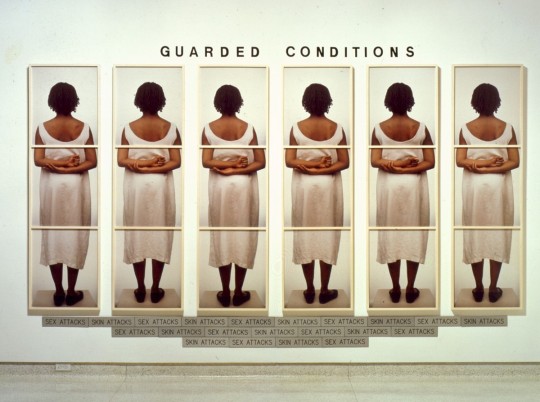
Lorna Simpson, Guarded Conditions (1989)
https://www.artspace.com/magazine/art_101/book_report/representing-the-black-body-lorna-simpson-in-conversation-with-thelma-golden-54624
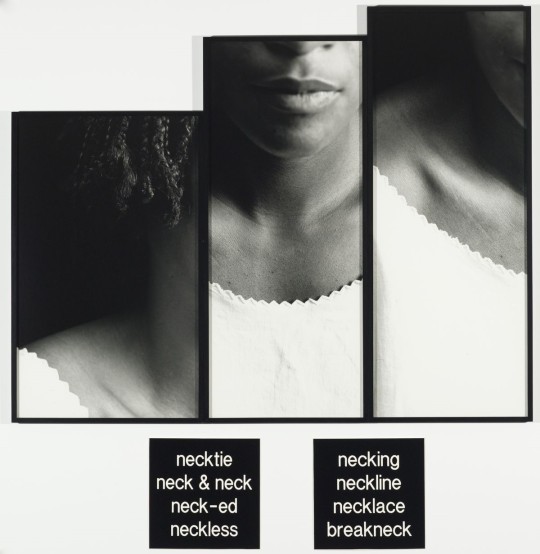
Lorna Simpson, Necklines (1989)
https://mcachicago.org/Collection/Items/1989/Lorna-Simpson-Necklines-1989

Lorna Simpson Wigs (1994)
https://www.moma.org/learn/moma_learning/lorna-simpson-wigs-1994/
Childhood
Born in Brooklyn in 1960, Lorna Simpson was an only child to a Jamaican-Cuban father and an African American mother. Her parents were left-leaning intellectuals who immersed their daughter in group gatherings and cultural events from a young age. She attributed their influence as the sole reason she became an artist, writing, "From a young age, I was immersed in the arts. I had parents who loved living in New York and loved going to museums, and attending plays, dance performances, concerts... my artistic interests have everything to do with the fact that they took me everywhere ...."
Aspects of day-to-day life lit up Simpson's young imagination, from the jazz music of John Coltrane and Miles Davis, to magazine advertisements and overheard, hushed stories shared between adults; all of which would come to shape her future art. The artist took dance classes as a child and when she was around 11 years old, she took part in a theatrical performance at the Lincoln Center for which she donned a gold bodysuit and matching shoes. Though she remembered being incredibly self-conscious, it was a valuable learning experience, one that helped her realize she was better suited as an observer than a performer. This early coming-of-age experience was later documented in the artwork Momentum, (2010).
Simpson's creative training began as a teenager with a series of short art courses at the Art Institute of Chicago, where her grandmother lived. This was followed by attendance at New York's High School of Art and Design, which, she recalls "...introduced me to photography and graphic design."
Early Training and Work
After graduating from high school Simpson earned a place at New York's School of Visual Arts. She had initially hoped to train as a painter, but it soon became clear that her skills lay elsewhere, as she explained in an interview, "everybody (else) was so much better (at painting). I felt like, Oh God, I'm just slaving away at this." By contrast, she discovered a raw immediacy in photography, which "opened up a dialogue with the world."
When she was still a student Simpson took an internship with the Studio Museum in Harlem, which further expanded her way of thinking about the role of art in society. It was here that she first saw the work of Charles Abramson and Adrian Piper, as well as meeting the leading Conceptual artist David Hammons. Each of these artists explored their mixed racial heritage through art, encouraging Simpson to follow a similar path. Yet she is quick to point out how these artists were in a minority at the time, remembering, "When I was a student, the work of artists from varying cultural contexts was not as broad as it is now."
During her student years Simpson travelled throughout Europe and North Africa with her camera, making a series of photographs of street life inspired by the candid languages of Henri Cartier-Bresson and Roy DeCarava. But by graduation, Simpson felt she had already exhausted the documentary style. Taking a break from photography, she moved toward graphic design, producing for a travel company. Yet she remained connected to the underground art scene, mingling with likeminded spirits and fellow African Americans who felt the same rising frustrations as racism, poverty, and unemployment ran deep into the core of their communities.
At an event in New York Simpson met Carrie-Mae Weems, who was a fellow African American student at the University of California. Weems persuaded Simpson to make the move to California with her. "It was a rainy, icy New York evening," remembers Simpson, "and that sounded really good to me." After enrolling at the University of California's MFA program, Simpson found she was increasingly drawn towards a conceptual language, explaining how, "When I was in grad school, at University of California, San Diego, I focused more on performance and conceptually based art." Her earliest existing photographs of the time were made from models staged in a studio under which she put panels or excerpts of text lifted from newspapers or magazines, echoing the graphic approaches of Jenny Holzer and Martha Rosler. The words usually related to the inequalities surrounding the lives of Black Americans, particularly women. Including text immediately added a greater level of complexity to the images, while tying them to painfully difficult current events with a deftly subtle hand.
Mature Period
Simpson's tutors in California weren't convinced by her radical new slant on photography, but after moving back to New York in 1985, she found both a willing audience and a kinship with other artists who were gaining the confidence to speak out about wider cultural diversities and issues of marginalization. Simpson says, "If you are not Native American and your people haven't been here for centuries before the settlement of America, then those experiences have to be regarded as valuable, and we have to acknowledge each other."
Simpson had hit her stride by the late 1980s. Her distinctive, uncompromising ability to address racial inequalities through combinations of image and text had gained momentum and earned her a national following across the United States. She began using both her own photography and found, segregation-era images alongside passages of text that gave fair representation to her subjects. One of her most celebrated works was The Water Bearer, (1986), combining documentation of a young woman pouring water with the inscription: "She saw him disappear by the river. They asked her to tell what happened, only to discount her memory." Simpson deliberately challenged preconceived ideas about first appearances with the inclusion of texts like this one. The concept of personal memory is also one which has become a recurring theme in Simpson's practice, particularly in relation to so many who have struggled to be heard and understood. She observes, "... what one wants to voice in terms of memory doesn't always get acknowledged."
In the 1990s Simpson was one of the first African American women to be included in the Venice Biennale. It was a career-defining decade for Simpson as her status grew to new heights, including a solo exhibition at New York's Museum of Modern Art in 1990 and a series of international residencies and displays. She met and married the artist James Casebere not long after, and their daughter Zora was born in the same decade. In 1994 Simpson began working with her grandmother's old copies of 1950s magazines including Ebony and Jet, aimed at the African American community. Cutting apart these relics from another era allowed Simpson to revise and reinvent the prescribed ideals being pushed onto Black women of the time, as seen in the lithograph series Wigs (1994). The use of tableaus and repetition also became a defining feature of her work, alongside cropped body parts to emphasize the historical objectification of Black bodies.
Current Work
In more recent years Simpson has embraced a much wider pool of materials including film and performance. Her large-scale video installations such as Cloudscape (2004) and Momentum (2011) have taken on an ethereal quality, addressing themes around memory and representation with oblique yet haunting references to the past through music, staging, and lighting.
Between 2011 and 2017 Simpson reworked her Ebony and Jet collages of the 1990s by adding swirls of candy-hued, watercolour hair as a further form of liberation. She has also re-embraced painting through wild, inhospitable landscapes sometimes combined with figurative elements. The images hearken to the continual chilling racial divisions in American culture. As she explains, "American politics have, in my opinion, reverted back to a caste that none of us want to return to..."
Today, Simpson remains in her hometown of Brooklyn, New York, where in March 2020, she began a series of collages following the rise of the Covid-19 crisis. The works express a more intimate response to wider political concerns. She explains, "I'm just using my collages as a way of letting my subconscious do its thing - basically giving my imagination a quiet and peaceful space in which to flourish. Some of the pieces are really an expression of longing, like Walk with Me, (2020) which reflects that incredibly powerful desire to be with friends right now."
Despite her status as a towering figure of American art, Simpson still feels surprised by the level of her own success, particularly when she compares her work to those of her contemporaries. "I feel there are so many people - other artists who were around when I was in my twenties - who I really loved and appreciated, and who deserve the same attention and opportunity, like Howardena Pindell or Adrian Piper."
The Legacy of Lorna Simpson
Simpson's interrogation of race and gender issues with a minimal, sophisticated interplay between art and language has made her a much respected and influential figure within the realms of visual culture. American artist Glenn Ligon is a contemporary of Simpson's whose work similarly utilizes a visual relationship with text, which he calls 'intertextuality,' exploring how stencilled letters spelling out literary fragments, jokes or quotations relating to African-American culture can lead us to re-evaluate pre-conceived ideas from the past. Ligon was one of the founders of the term "Post-Blackness," formed with curator and writer Thelma Golden in the late 1990s, referring to a post-civil rights generation of African-American artists who wanted their art to not just be defined in terms of race alone. In the term Post-Black, they hoped to find "the liberating value in tossing off the immense burden of race-wide representation, the idea that everything they do must speak to or for or about the entire race."
The re-contextualization of historical inaccuracies in both Simpson and Ligon's practice is further echoed in the fearless, cut-out silhouettes of American artist Kara Walker, who walks headlong into some of the most challenging territory from American history. Arranging figures into theatrical narrative displays, she retells horrific stories from the colonial era with grossly exaggerated caricatures that force viewers into deeply uncomfortable territory.
In contrast, contemporary American artist Ellen Gallagher has tapped into the appropriation and repetition of Simpson's visual art, particularly her collages taken from African American magazine culture. Gallagher similarly lifts original source matter from vintage magazines including Ebony, Our World and Sepia, cutting apart and transforming found imagery with a range of unusual materials including plasticine and gold-leaf. Covering or masking areas of her figures' faces and hairstyles highlights the complexities of race in today's culture, which Gallagher deliberately teases out with materials relating to "mutability and shifting," emphasising the rich diversity of today's multicultural societies around the world.
3 notes
·
View notes
Text
Cincinnati Once Declared ‘No Irish Need Apply’
It was a stormy December evening in 1867, but the weather failed to prevent hundreds of outraged Cincinnatians from assembling at Mozart Hall. In a session as tumultuous as the deluge outside, the assembly approved a resolution condemning England for imprisoning naturalized American citizens on charges of treason against their former homeland by participating in an Irish uprising.
Among the orators that night was attorney Milton Sayler, who enthused about the worthiness of America’s adopted citizens. Sayler specifically noted that many of the imprisoned Irish-Americans had served valiantly during the Civil War.
“In the dark days of 1862, ’63 and ’64, when . . . the whole North was called into the field to protect the flag of this country . . . I recollect then the recruiting offices in this city. I recollect Col. Jones’ office. There was no sign up over Jones’ office saying that no Irish need apply.”
Attorney Sayler referred, of course, to signs that did appear in Cincinnati around that time. From about 1855 to about 1895, it was quite common for employment advertisements in Cincinnati to specify, “No Irish Need Apply.” The phrase was so prevalent that popular songs by that title entertained vaudeville audiences.
Although other ethnic groups, notably Italians, Jews, Poles and Hungarians were beginning to migrate into the Ohio Valley, Cincinnati advertisements did not attempt to discourage any other group except the Irish from applying for jobs.
Irish immigrants began arriving here along with a great wave of Germans around 1848. The Germans landing at that time had fled the failed 1848 revolutions throughout the tottering feudal empires of Europe. The Irish emigrated to escape the deadly Potato Famine. Throughout the 1800s, German immigrants accounted for as much as one-third of Cincinnati’s total population, but the Irish constituted more than 10 percent – reaching nearly 15 percent in some censuses.
As the destination of so many immigrants, Cincinnati was heavily involved in spawning a reactionary movement officially named the Native American Party but popularly labeled the “Know Nothing” party. This political organization, which enjoyed great success in the 1850s, particularly despised Roman Catholicism, a religion espoused by almost all the Irish immigrants and many Germans. It was around the pinnacle of Know Nothing power that the “No Irish Need Apply” tags began appearing around Cincinnati.
Among such large populations, it is difficult to generalize, but it the Irish immigrants often pursued less-skilled occupations, compared to immigrants from Germany. In fact, it was often the case that Irish workers attacked African American laborers competing for the same jobs in Cincinnati. A vicious riot here in 1862 grew out of Union Army successes in the Civil War. As Northern militias pushed southward, they freed large numbers of slaves, who rushed northward as quickly as they could manage. Arriving in Cincinnati, the freed slaves, who commanded much smaller salaries, quickly took over jobs that had been held by Irish immigrants. At the Burnet House hotel, for example, fifty Irish chambermaids were replaced overnight by African Americans. According to historian Frank L. Klement, Irish aggravation erupted into violence:
“On July 15, Irish workers drove newly-hired blacks off boats and docks. The rioting spread and the Irish-Americans invaded ‘Shantytown’ or ‘Bucktown,’ terms applied to the section of the city inhabited by black residents. The riotous Irish put some homes to the torch and beat up every black man who did not flee. Blacks retaliated by burning some buildings in ‘Dublin,’ the Irish section of the city.”
The adjacent – if antagonistic – relationship between Irish and black workers suggests that anti-Irish sentiments were closely related to the prejudice and segregation endured by African Americans. Native-born Americans, in other words, lumped both groups in the same category and treated them similarly. It is notable that relatively few advertisements specified that no African Americans need apply because, unless the ad specifically invited black applicants, it was understood that only whites could apply..
The Irish historically used any mechanism available to separate themselves from African Americans, whether physically segregated neighborhoods, religious affiliation or politics. For more than a century, Irish Catholics constituted a pillar of the segregationist Democratic Party. The feeling was mutual. The Cincinnati Enquirer [4 July 1868] reported a Chicago newspaper advertisement reading:
“Wanted – In a respectable colored family, a white woman to do general housework. Apply at 73 Carroll street. No Irish need apply.”
By 1910, the Cincinnati Enquirer (at that time a Democratic newspaper) published a paean to Irish Americans, noting that the once offensive signs discriminating against the Irish were now collectors’ items:
“But each recurring seventeenth of March serves to recall to us some important facts in connection with the Irish; for instance, that there are no longer notices in the newspapers or signs out that ‘No Irish need apply.’ It happens that we hunt them up now.”
Still, the sting of that discrimination persisted. The formidable Marianne O’Reagan, doyen of the Cincinnati Post’s editorial pages, recalled meeting as a young reporter with one of Cincinnati’s high-society ladies, who, upon learning of O’Reagan’s Irish ancestry, commented that she had never met anyone of Irish ancestry outside her own kitchen. O’Reagan commented:
“The ‘No Irish Need Apply’ signs might have been down in Cincinnati in the 1950s, when the exchange took place, but the memory certainly lingered on.”
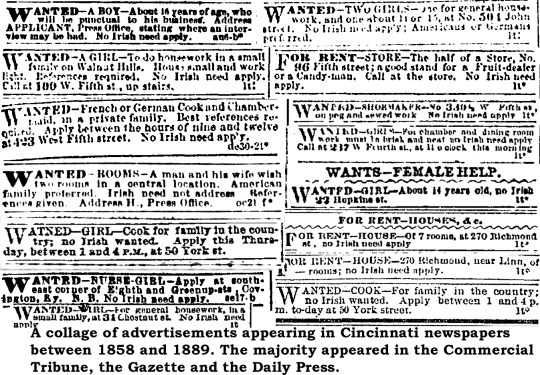
3 notes
·
View notes
Photo

I Shot Andy Warhol (1996) is a dynamic, true crime, avante garde film that explores the history and complexity of the relationship between famous artist Andy Warhol and radical feminist Valerie Solonas. The true events depicted in this film are told through a mixture of narratives that both highlight the socio-political climate of the 1960s and the struggle for female identifying empowerment. I thought it was particularly interesting that the film was first intended to be a documentary about Valerie Solonas, but the filmmakers could not find enough footage of her, nor any individuals to speak about her. Throughout the film, the various narrative perspectives mirror a documentary styled memoir. Mary Harron tells Valerie’s narrative using a combination of flashback narratives, self recorded home videos of ‘Valerie’ reading from her own Manifesto as it pertains to the current storyline, and an unnamed character reading Valerie’s file referring to her as ‘the patient’. The last narrative technique allows the viewers to gain some context surrounding both Valerie’s intentions and behaviors. The unnamed narrator discloses Valerie’s history with being molested, prostitution, homosexual activity, and ultimately her belief in ‘the natural superiortiy of women over men’. These biographical narratives ultimately illustrate a much bigger picture than just the relationship between the two.
.
The key themes highlighted in I Shot Andy Warhol include superiority, ironic male validation, radical feminism + matriarchy, mental illness, revolution, lesbianism, and revenge.
.
Valerie’s detrimental motives as a protagonist in this film are driven by her attitudes toward female superiority over men. Valerie’s constant push to educate the masses on her S.C.U.M Manifesto (Society for Cutting Up Men) is bound by the idea that women are biologically superior. Within this superiority complex is a duality of anti-man rhetoric, paired with using men for her advantage when she needs to. I found it ironic that while Valerie is so anti man, a recurrent theme in the film is the chase for male validation; especially Andy. From the first time Andy Warhol’s name is mentioned in the film, Valerie is desperate to get Andy’s attention in hopes that his connections and artistry will help her spread her radical views through media. Valerie constantly pushes her beliefs onto Andy and even gives him the only other copy she has of her screenplay for him to read. Even after begging Andy to read it, he dodges Valerie’s push for production but still holds onto her beloved copy. This stands as a symbol of Andy still holding a piece of ownership over her but refusing to give her the validation she is chasing. As mentioned in the original report, Valerie’s erratic behavior and radical beliefs stem from a comorbidity of mental illness, likely OCD and Schizophrenia. It is revealed at the end that Valerie is sent to a ‘Hospital for the Criminally Insane’ following the shooting. While it is unclear to the audience whether or not Valerie realizes her diagnosis, Valerie’s mental health is obvious to the other characters. Valerie sees herself as a revolutionary, while others (specifically men) consistently label Valerie as a ‘lunatic’ and insane for her beliefs. There is a wide gap in perspective from Valerie’s view of herself versus other’s interpretation of her.
.
The cinematic aspects of the film were what captivated me the most while watching. One recurrent technique throughout the film was the specific and deliberate use of the color red, red lighting in particular. The first time Valerie visits The Factory trying to find Andy, the lighting surrounding her is a shadowy, transparent red glimmer focused on her face. When Valerie goes to meet with the publisher to sign her book contract, she specifically picks out and wears a red dress. After being ‘excommunicated’ from Andy and his group and going to confront him, there is dark red light surrounding the group as they walk out of a tunnel. However, when Valerie’s face enters the frame to speak to Andy, the red light behind the group disappears and the light shown on Valerie’s face is harsh and bright white. The repetitive incorporation of the color red stands in as a symbol for many emotions and moods, such as: embarrassment, frustration, humiliation, bloodlust, romance, need for validation, and superiority.
.
The visual techniques during the party scene at The Factory were especially noticeable. The bright, saturated, revolving and color changing lights stood to amplify the mood of the party for those in attendance. The mixture of light movement paired with diverse colors and patterns added a layer of intoxication to the scene and reflected how the party-goers were feeling under the influence.
.
I think the most important cinematic aspect in this film were the deliberate mirroring shots to tell different aspects of the same narrative. During the scene of the party at The Factory, both Andy and Valerie are surrounded by people but standing alone. They both slowly look up and make eye contact with one another from across the room as the camera pans in on each individual. The last scene of the film depicts Andy standing in a crowd surrounded by others, when he hears a popping sound reminiscent of a gunshot. This triggers Andy to turn around as he sees Valerie standing alone directly across the street. The two once again make eye contact, and in the same angle as before, the camera pans into both individuals’ reactions. Andy stares nervously and Valerie disappears after a car passes by. While both shots mirror one another in technique, the emotion and context behind both are drastically different. The first implicates admiration and need for validation, while the final shot indicates fear from Andy and accomplishment from Valerie.
.
Many aspects of the film are reflective of the time period being portrayed in the film. As mentioned in the original report, this film took place during the Vietnam War in the 1960s, where the socio-political climate was extremely volatile and filled with protest and anti-government and anti-war sentiments. While I do not think anti-war attitudes were presented at the forefront of this film, or even mentioned more than once, I do think that Valerie’s passionate and revolutionary motives were inspired from the political climate during this time period.
.
The set design and costumes were also extremely reflective of the 1960s. The ‘retro’ aesthetic of this time period can be found within sets such as the old fashioned classic diner and especially The Factory. A ‘cinema fact’ on the back of the DVD case revealed that Harron and the filmmakers were given permission to reproduce some of Andy Warhol’s paintings and silk screen for the set, but they had to destroy them after filming. One could argue that the set of The Factory is more reminiscent of Andy Warhol’s artistry, which is ultimately a reflection of his peak during this time period.
.
Even attitudes of the characters were reflective of the oppression of certain identities during this time, especially lesbians and trans people. Valerie is consistently degraded by the men around her for being a lesbian, most harshly insulted when she was the only woman in the room. Feminine heterosexual women portrayed in the film were also degraded and stereotyped, but in a hypersexualized way that the men validated as attraction. Degradation towards Valerie came from a homophobic standpoint that was not based on attraction. For example, when Valerie appeared on the television interview, the man rudely demeaning her while discussing the ‘controversial’ topic of homosexuality cited the Kinsey Reports. Debuted in the late 1950s, the Kinsey Reports introduced the concept of sexuality as a spectrum and changed the way a lot of people viewed homosexuality in general, for better or worse.
.
I think one thing that stuck out to me the most throughout the course of the film was that it seemed as if S.C.U.M. and its manifesto was inclusive of all womxn identities. Even the ad in the newspaper seeking actors to audition for the screenplay “Up Your Ass” directly welcomed ‘butch dyke lesbians’ and queer people. However, towards the end of the film when Valerie was convinced that Candy had worked with Andy to set her up, Valerie cruelly invalidated Candy’s identity as a transwoman and called her a man. This invalidation is not only misogynistic and exclusive to trans people but is especially demeaning to say to a friend who originally brought you into the scene. At first I was excited and even surprised to see trans representation within the film. Although it was disappointing to see transphobia shine through, especially from Valerie, this type of fear and intolerance was common and is still common surrounding trans identities.
.
It was fairly hard for me to actually get a physical copy of and view this film, and I believe it was well worth the difficulty. This film is an intimate storyline of a historic and iconic incident that stands to narrate more than just a dynamic relationship. – ECo
2 notes
·
View notes
Text
Brief History of Type
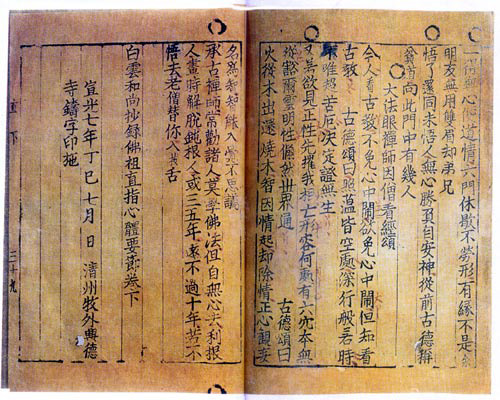
Printing with moveable type actually started in China and Korea in the 8th century AD and printed type (via wood block printing) began to be distributed. In Japan, a devout empress commissioned one million copies of a prayer for distribution to pilgrims. During this time a print runs took six years to complete.
In the middle of the 15th century a German goldsmith Johannes Gutenberg invents moveable metal type and the printing press.

Print and typography were transformational in many ways. For example, typography helped seal the notion of “text” as a complete work, a stable body of ideas in one form.
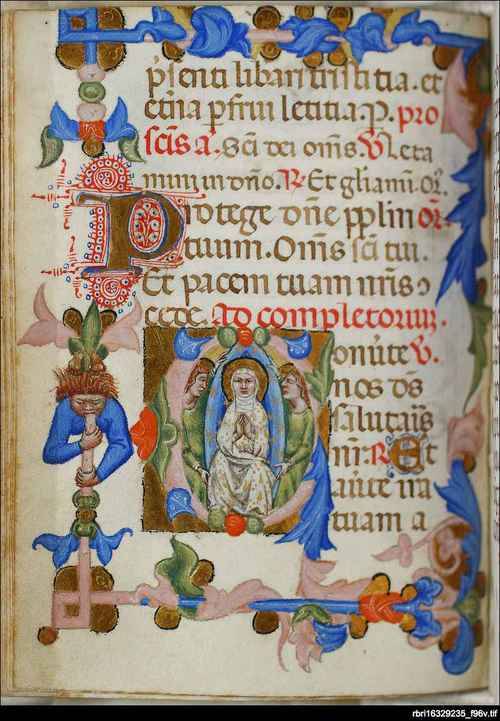
Before the printing press, books were produced by scribes circa the 12th century.
When Gutenberg produced his first typeface, he designed the typeface that was popular at the time. This first type was called “Black letter”.
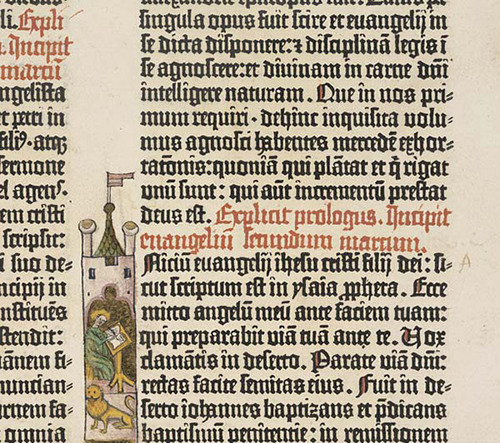
Black letter is a descendant of “Caroline minuscule”, a calligraphic script developed in Charlemagne’s empire (800-1100 AD). Blackletter soon got competition from "humanist" typefaces created during the 15th century by Venetian printers. These typefaces looked more like writing found in the humanistic (renaissance) manuscripts of the time. Most printers started using “humanist”-style fonts but Germans were not swayed: they used Blackletter or “Fraktur” until the 20th century.
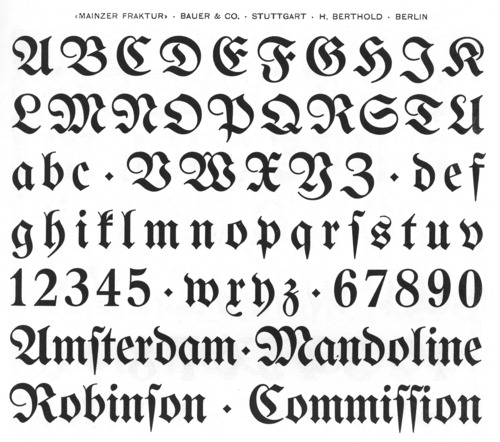
In the first decades after the invention of print, type designers drew their inspiration from handwriting or calligraphy. Frenchman Claude Garamond completed the development of transitional typeface with his typeface. Garamond gives up on trying to imitate handwriting, for him, type becomes its own art. “Garamond” becomes the most popular typeface in Europe.
Transitional typeface
“Transitional” type is so-called because of its intermediate position between old style and modern. The distinguishing features of transitional typefaces include vertical stress and slightly higher contrast than old style typefaces, combined with horizontal serifs.
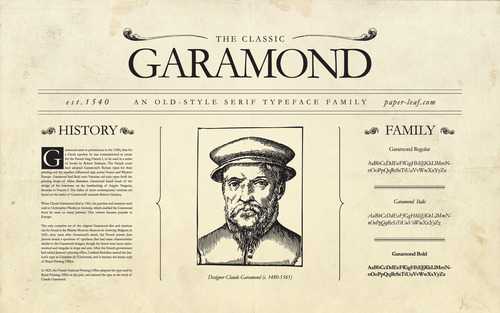
Master calligrapher John Baskerville (1706–1775) wanted to improve legibility and worked hard to create typefaces with sharpness and contrast unlike anything else at the time.

Firmin Didot (1764–1836) created what is considered the first Modern typeface. ``Modern’’ typefaces are distinguishable by their sudden-onset vertical stress and strong contrast. Modern serifs and horizontals are very thin, almost hairlines. Although they are very striking, these typefaces are sometimes criticized as cold or harsh, and may not be quite as readable for very extensive text work, such as books.

The industrial revolution shaped the 19th century - and it also shaped typography. Mass production led to mass consumption, which led to mass communication. Advertising exploded and with it the need for bold in-your-face type, soon typefaces of all widths and heights appeared. Serifs lost their role as finishing details and became independent components.
20th Century
In the early 20th century avant-garde artists went a step further in rejecting historical letterforms. Following the Bauhaus credo of radically simplified forms and functionality, Paul Renner designed Futura based on simple geometric shapes. In his quest for simplicity, Renner avoided all decorative non-essential elements.
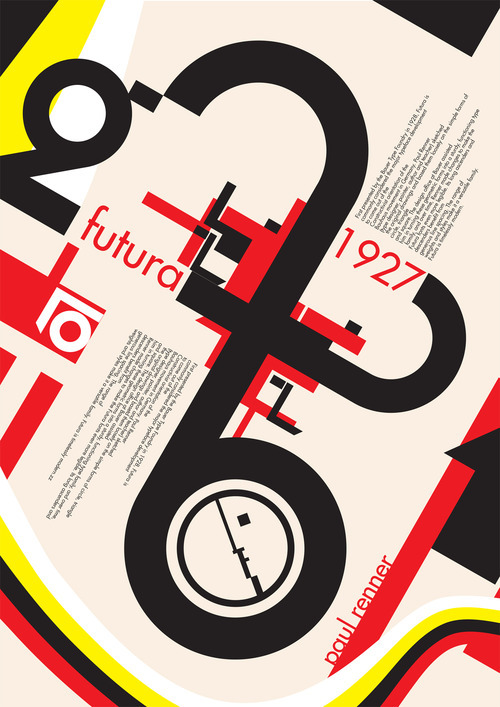
Futura has a refined yet cool element, so when Swedish furniture retailer IKEA abandoned Futura in their catalogues for Verdana (a Microsoft-produced online font), it received severe complaints from customers.

1957
Helvetica is everywhere. Born in neutral Switzerland in 1957, its neutrality soon took the world by storm. Business quickly embraced the clear but honest look and soon it became the font of choice for logos, transport signs, and product packaging. Today, it is virtually impossible in America to spend a day without somehow seeing the font.

1950’s
After the proliferation of typefaces Concrete Poetry became popular. Coined in the 1950’s Concrete poetry or shape poetry is poetry in which the typographical arrangement of words is as important in conveying the intended effect as the conventional elements of the poem, such as meaning of words, rhythm, rhyme and so on.
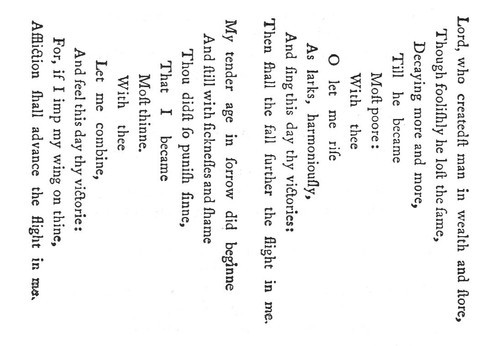
It is sometimes referred to as visual poetry, a term that has evolved to have distinct meaning of its own, but which shares the distinction of being poetry in which the visual elements are as important as the text.

Phototypesetting, 1950s: this machine projects light through a cut-out of a font character, onto a film that is then treated chemically to bear the mark permanently. This system has the advantage of scalability — magnifiers can be used to adjust the size of the type image freely, without having to bring in a new font cutout. Of course, digital vector technology would soon leave this advancement in the dust.
1977
On April 1, 1977, the Guardian newspaper published a seven-page supplement on the island of San Seriffe, a nation celebrating ten years of independence. The country consisted of two main islands, Caissa Superiore (Upper Caisse) and Caissa Inferiore (Lower Caisse). The capital city, located on Upper Caisse, was the city of Bodoni. Other cities included Port Clarendon, Garamondo and Cap Em (printed with full map and description). Of course, the islands were not real, but many readers called the newspaper wanting to book a vacation. The elaborate typography prank was one of the most successful in history and has spawned online travel guides and more. Why was it so successful? It happened right before the PC revolution, when suddenly everybody could become a type expert.
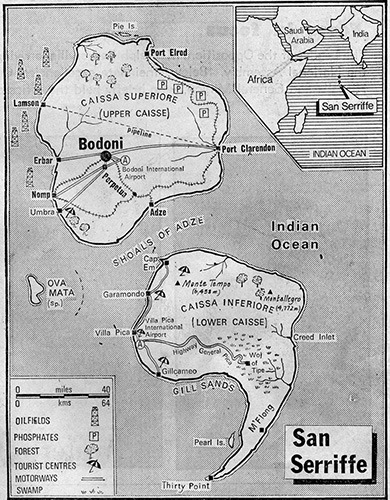
The reason that even people who do not care one bit about typography know several fonts and some specialist terms, is the personal computer. Specifically, the first Mac. Steve Jobs had attended a calligraphy class in college which left such a great impression on him that he pushed hard to have several typefaces included on the first Mac. At the time, this was a revolutionary concept but it set in motion the proliferation of digital fonts we know today.
Digital typography (mid 1980s – present)
Bitmap (raster) fonts: a data file that contains glyphs in pixel form. Because it is not scalable like a vector, a bitmap font must contain many sets of pre-determined sizes (traditionally just 8, 9, 10, 12, 14, 18, 24, 36, 48, and 72pt), each in every permutation of regular, bold, and italic.
Bitmap font formats: PCF, BDF, SNF, DWF, BF, AFM, FON, BMF, PSF, PK
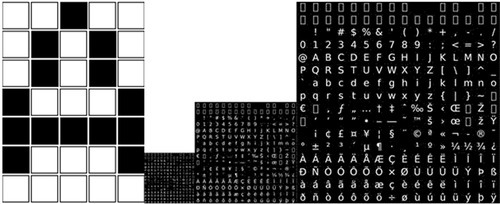
A pixilated bitmap character (image from Wikimedia Commons) and bitmap files for 3 font sizes (image fromJOT)
Outline (vector) fonts - sets of mathematically described lines and curves that trace the outline of glyphs. They are infinitely scalable without pixilation.

Vectorized font (image from Adobe)

The computer era came with the promise of unlimited font choices.
Fonts soon got used in grotesque ways, the worst offender being Comic Sans, a quirky hand-writing font distributed through Microsoft’s operating system. Intended as a script for an animated dog, Comic Sans became popular because it was part of Microsoft Windows’ standard font package.

Since everybody had a PC, fonts in Windows became pretty much default standards. The rise of Times New Roman, for example, is directly correlated with this phenomenon.
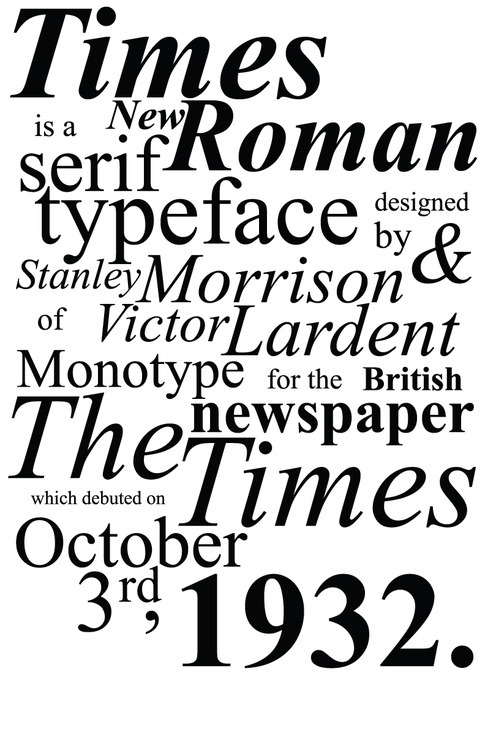
For a long time, the Internet ran on a few fonts, namely those available on most computers. A few years ago this changed with the introduction of CSS3 and faster broadband speeds. Now, websites can display fonts delivered through the web and the world is better of because of it.

2007
On September 25, 2007, Vicki Walker put this in an email and pushed send: TO ENSURE YOUR STAFF CLAIM IS PROCESSED AND PAID, PLEASE FOLLOW THE BELOW CHECKLIST. Her company in New Zealand did not like her use of the caps lock button and fired her for sending “confrontational emails”. Walker won damages in court but the episode tells us something about the power of typography. We don’t like to be screamed at in our face and WE DON’T LIKE TO BE SCREAMED AT ON OUR SCREEN. LET THAT BE A LESSON FOR ALL OF US.
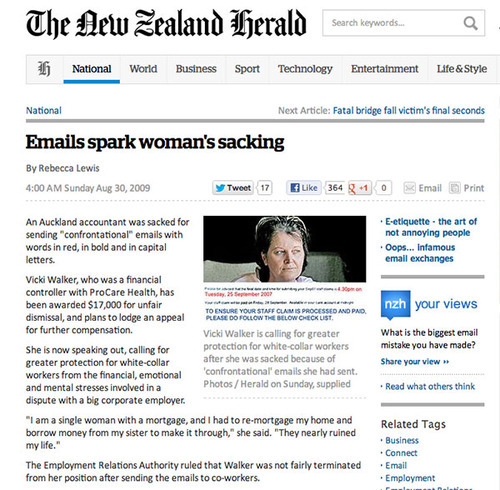
What are the most popular fonts of all time? The poster below combines various Top 100 lists and puts Helvetica, Futura and Bodoni in the top three spots.
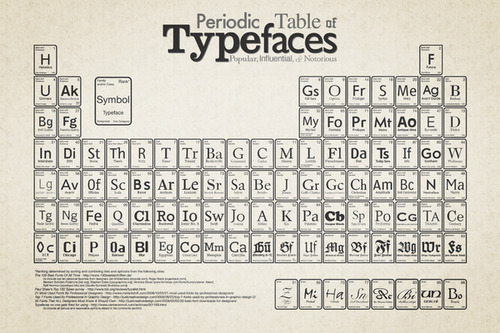
Typeface Terminology
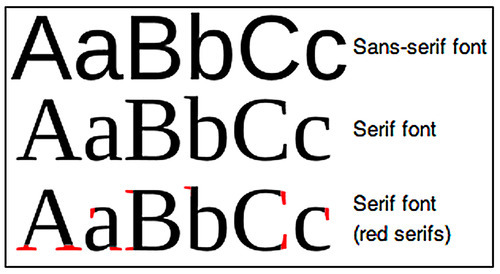

Works inspired by typeface design
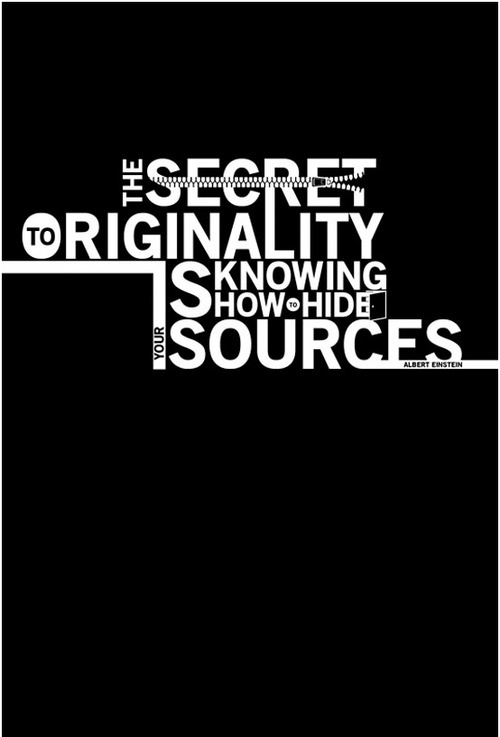

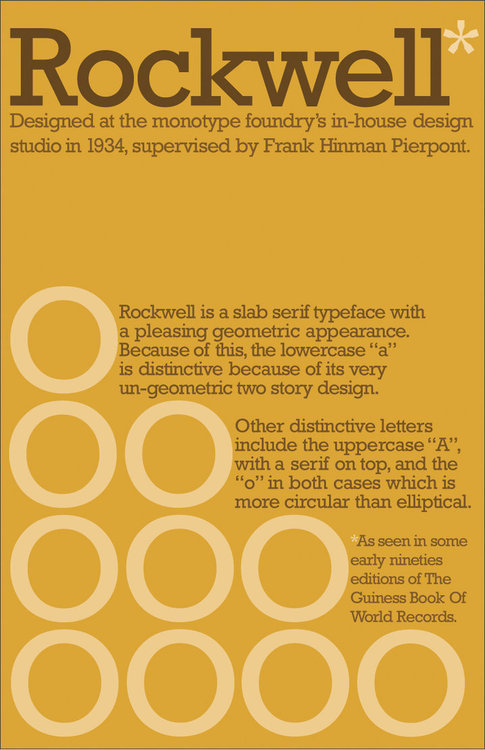




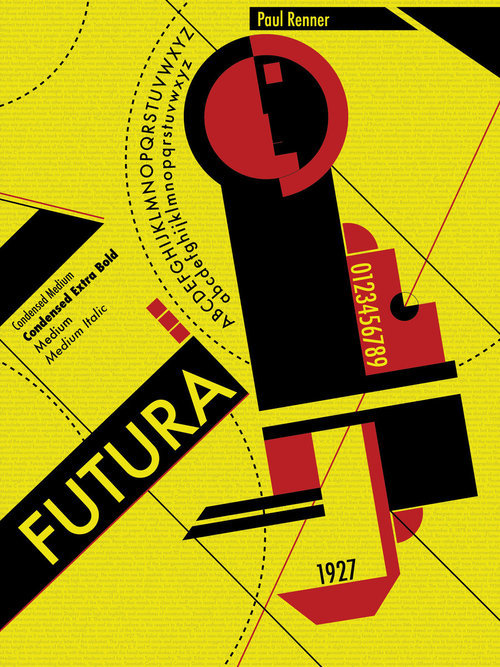
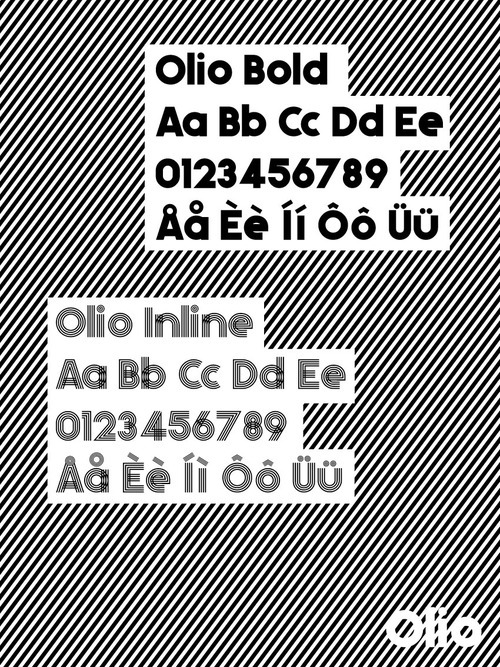
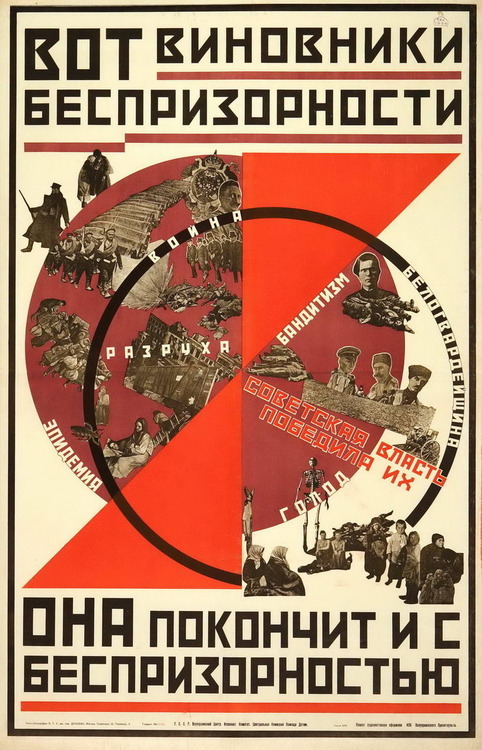
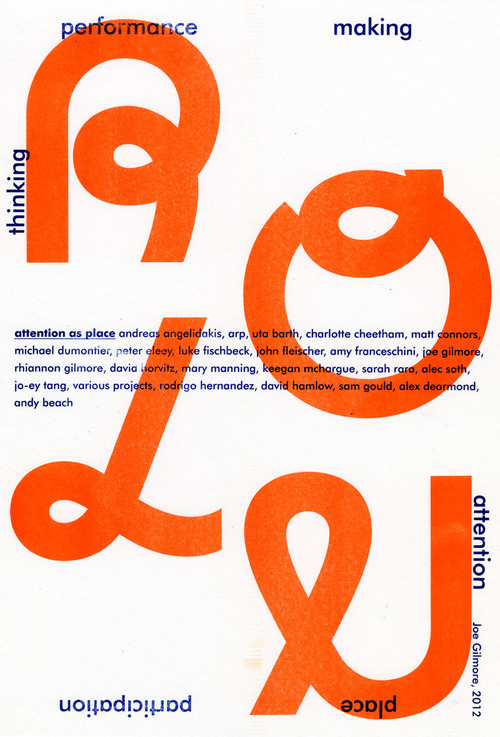
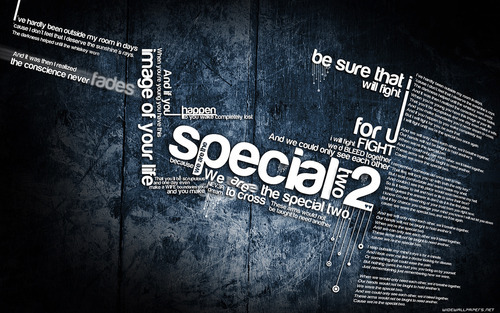
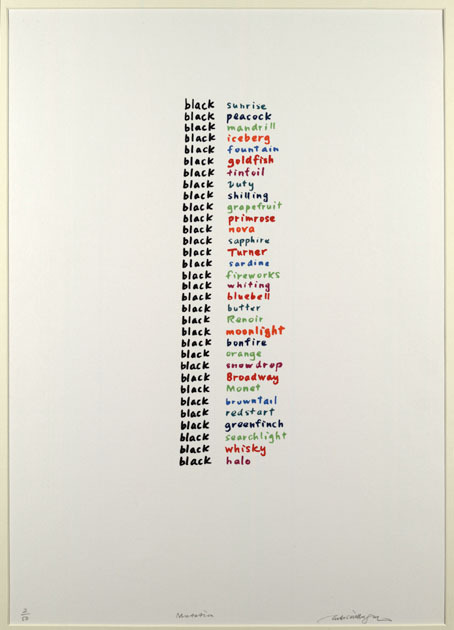

2 notes
·
View notes
Text
Images of Females Advertising Dove
Dove has been around for decades since the 1950’s and it has changed its marketing style since launched. Dove in the beginning had only white faces and today its very diverse. Dove now aims towards diversity and produces products for different skin types. Within the last two decades the brand has promoted positive body image, became more diverse in terms of ethnicity, gender, and race. From the beginning where the models were white and thin until present time, where we have a host of many beautiful shades and sizes of women.

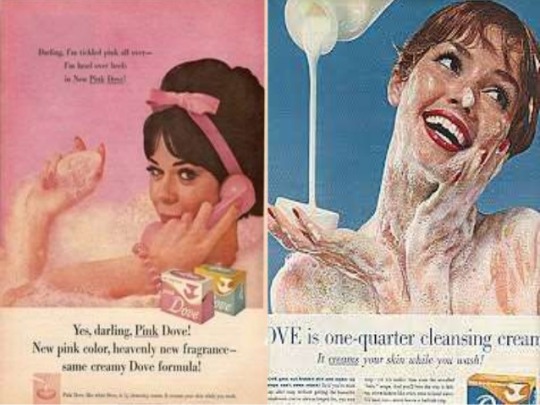
“The Use of Black Models in Advertising” This article was published in 1971, the article was about the reasons why black models are used for advertising. According to the article black models are used in marketing to sell products to black people. After the civil rights movement and new laws created in the legislature, marketers had to prepare for a new world in which black people would have a voice and more money to buy their products. As well as whites realizing that “black money” is the same as “white money”, both are green; so, with that realization, white businessman became smarter and began marketing black people in positive light for profit.
In the 1950’s concerning size, women were more concerned about having a slim figure, the ‘ideal’ size for attracting a man; Most ads you see on tv or in the magazines/newspapers in the 20th century would be of a slender sized woman, in addition, everyone was attracted to that size. Most of the advertising from the 50’s to the 70’s lacked people of color and of plus sized. I noticed that they choose light skinned black women over dark-skinned black women. As time passed, they began implementing dark skinned women. Marketers usually produced what they felt would sell and what attracts people to buy their products. The secret to advertising is subliminal messaging; subliminal messages is to gain favor with the consumer you’re targeting. For instance, if marketers placed more curvier women in their ads the world would be more accepting.
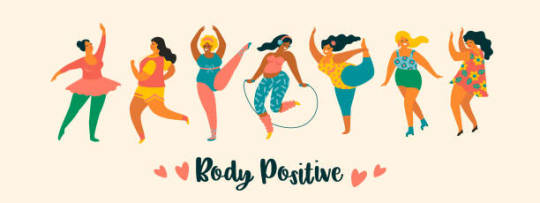
The early 2000’s Mo’nique (comedian/actress) sort of pushed away the fat shaming when she glorified her size. Mo’nique made ‘fat’ girls feel more beautiful and accepted. In 2005 She hosted the first televised beauty competition and boot camp for full-sized women “F.A.T. Chance,” on the Oxygen station. Mo’nique encouraged other plus size women to love the body they’re in and that they too are normal. “With its debut in 2005 it was the highest-rated original show in the company’s history, and in the second season it had a total of 4.8 million viewers for the premiere and its encores” (Luckily, There’s Plenty of Her for Everybody). There's a market for plus sized women just as there is for ‘regular’ sized women. The views on that show proved that people are interested in a plus sized/curvy woman's lifestyle also people support the body images. The ratings definitely boosted confidence in other plus sized women. Everyone comes in different sizes and should love every inch of themselves and only change for themselves, and of course for a healthier you. “Women are more than the labels that are given to us, they're more than an age, more than a size, more than a name...” (Dressbarn Launches an Empowering Campaign Starring Ashley Graham).

You’d be surprised the amount of negativity and pressure women endure daily, in terms of body image. Super model Tyra Banks has been shunned for her body a few times in her modeling career. It has become so bad that it took a toll on her career. “Banks said her desire to be her own boss came from rejection she faced for her skin color and curvier figure, which she said was not desirable in the world of high-fashion modeling. “Me being a boss came from pain,” she said. “Being told no you can’t.” ...” Those experiences “created in me an empathy for women and physical discrimination,” (Tyra Banks on Body Shaming in the Fashion Industry: ‘My Pain Turned Me Into a Boss’). Banks kicked off her own show “Americas Next top Model”, there she featured models of many sizes and ethnicity's. She also featured women who were more on the heavy side, also known as ‘plus sized’. Banks also bridged the way of women flaunting, loving their bodies no matter their size. “Body-positive advertisements often feature individuals helping others recognize their inner beauty, and these images of support and kindness could potentially evoke elevation in audiences” (Feeling Bad About Feel-Good Ads: The Emotional and Body-Image Ramifications of Body-Positive Media).
youtube
In 2017, Dove offered a Nigerian lady Lola Ogunyemi, to be the face of a new body wash campaign. Lola was excited for the Opportunity, stated, “Having the opportunity to represent my dark-skinned sisters in a global beauty brand felt like the perfect way for me to remind the world that we are here, we are beautiful, and more importantly, we are valued” (I am the woman in the 'racist Dove ad'. I am not a victim), however the commercial sparked a lot of negative backlash due to the content of the advertisement. Due to all the negative comments and controversy around the ad, it was removed, and Dove apologized if they came off as ‘racist’. Besides the backlash the brand has received, I thought it was a great opportunity for Dove to display a dark-skinned person and show the world that dark skin women are real, and beautiful.
“I know that the beauty industry has fueled this opinion with its long history of presenting lighter, mixed-race or white models as the beauty standard. Historically, and in many countries still today, darker models are even used to demonstrate a product’s skin-lightening qualities to help women reach this standard” (I am the woman in the 'racist Dove ad'. I am not a victim).

Although women are still body shamed and go to extreme measures to get the ‘perfect’ body Dove has launched a “Real Beauty campaign”, encouraging people all over the world to flaunt their imperfections and love themselves. “...viewing body-positive advertisements, as compared to traditional beauty ads, sparks stronger emotional responses, including both positive and negative emotions” (Feeling Bad About Feel-Good Ads: The Emotional and Body-Image Ramifications of Body-Positive Media). Under the Real Beauty campaign is the “Self Esteem Project”, “According to the research, 61% of girls between the ages of 10 and 17 in the U.K. lack confidence and body esteem, while nine in 10 girls with low body esteem are likely to put their health at risk trying to conform to what they believe is expected of them. Dove is spending 1.5 million pounds on the campaign, which also offers free advice and support around the issues of self-esteem on the Dove web site” (Dove spearheads ‘Self Esteem Project’ to salute and honor real girls). Dove works with non-professional models to help with the campaign to help build positive body confidence in the girls.

Over the past few years Dove has been pushing towards more diversity and knocking out beauty stereotypes. Dove works with people nationwide from infants to elderly people from shades of lighter skinned to shades of darker skins. Big, small, short, tall, slim, hefty, you name it, all types of people. People with physical disabilities, skin conditions i.e, vitiligo. People with ‘bad’ acne, crooked teeth, missing teeth, birth marks, nappy hair, straight hair, short hair, long hair, locked hair, a whole variation of people. Size and color of skin doesn’t define you, when you look at yourself in the mirror you should love every inch of yourself, and if weight is an issue that bothers you, get in the mind set of changing your weight. I just want everyone to know we all are beautiful in our own way.

On their website, Dove welcomes everyone and gives you a feel of comfort that purchasing their product would be one of the best decisions you’ve made in terms of beauty. “Welcome to Dove…the home of real beauty. For over a decade, we've been working to make beauty a source of confidence, not anxiety, and here's where the journey continues. Beauty is not defined by shape, size or color – it’s feeling like the best version of yourself. Authentic. Unique. Real. Which is why we’ve made sure our site reflects that. Every image you see here features women cast from real life. A real life version of beauty...” (Dove). Dove is displaying that there are different forms of beauty.

I love the approach that Dove has taken, it’s allowing the younger generations to see that they are beautiful and that the models they see on tv are superficial, yet the models are beautiful as well. Society has deemed being ‘fat’ to be ugly! Being darker skinned to be ‘ugly’! Being gay abnormal! The beauty campaign of Dove has helped millions recognize that you can look pretty without any makeup and you can love yourself no matter what condition you’ve been diagnosed with. You can still relate to others because we all have imperfections.

Society today has left many of us questioning our true selves. "Am I too fat?", "Am I really ugly?" , "Will I be accepted regardless of my sexual orientation?". Despite pondering our insecurities, DOVE has helped many people like you & me recognize our natural beauty. From my personal experience, using DOVE has made my skin feel so radiantly beautiful which has reflected beauty in my self image. Using DOVE has not only allowed me to recognize the beauty in myself but also in the beauty that would open up to those around me. The DOVE campaign demonstrates a relatively natural use of soap that encompasses beauty and self-image. This soap has a diverse ability to help make us appreciate both our physical and mental forms.
youtube
youtube
youtube
References
Kraus, A., & Myrick, J. G. (2018). Feeling Bad About Feel-Good Ads: The Emotional and Body-Image Ramifications of Body-Positive Media. Communication Research Reports, 35(2), 101–111. https://doi-org.libserv-prd.bridgew.edu/10.1080/08824096.2017.1383233
JOHN J. WHEATLEY. The Use of Black Models in Advertising. Journal of Marketing Research, [s. l.], v. 8, n. 3, p. 390, 1971. DOI 10.2307/3149585. Disponível em: http://search.ebscohost.com/login.aspx?direct=true&db=edsjsr&AN=edsjsr.10.2307.3149585&site=eds-live. Acesso em: 26 nov. 2019.
“Dove Spearheads 'Self Esteem Project' to Salute and Honor Real Girls.” Los Angeles Times, Los Angeles Times, 27 Dec. 2017, https://www.latimes.com/fashion/la-ig-wwd-dove-self-esteem-project-20171227-story.html.
Lee, Felicia R. “Luckily, There's Plenty of Her for Everybody.” The New York Times, The New York Times, 5 Aug. 2007, https://www.nytimes.com/2007/08/05/arts/television/05lee.html.
Lopez, Ricardo. “Tyra Banks on Body Shaming in the Fashion Industry: 'My Pain Turned Me Into a Boss'.” Variety, 6 June 2018, https://variety.com/2018/film/news/tyra-banks-on-body-shaming-in-the-fashion-industry-my-pain-turned-me-into-a-boss-1202834241/.
Ogunyemi, Lola. “I Am the Woman in the 'Racist Dove Ad'. I Am Not a Victim | Lola Ogunyemi.” The Guardian, Guardian News and Media, 10 Oct. 2017, https://www.theguardian.com/commentisfree/2017/oct/10/i-am-woman-racist-dove-ad-not-a-victim.
“Welcome to Dove.” Dove US, https://www.dove.com/us/en/home.html.
Williams, Lashauna, and Lashauna Williams. “Dressbarn Launches an Empowering Campaign Starring Ashley Graham.” InStyle.com, 7 Dec. 2019, https://www.instyle.com/fashion/ashley-graham-dressbarn-more-than-a-name-campaign.
4 notes
·
View notes
Text
UNIT EIGHT- AUDIENCE/VISIBILITY- SLSL: REFERENCES: HOW TO TELL STORIES
There are millions of ways to tell a y. For this project we are being encouraged to think about the specific mechanics of how you can tell a story- broadening the perspective of my horizon as an illustrator. I have taken most of the artists given in the brief document to explore some of the more ‘event’ friendly ways of telling a story.
Janette Paris- ANIMATION AND STRIP COMIC
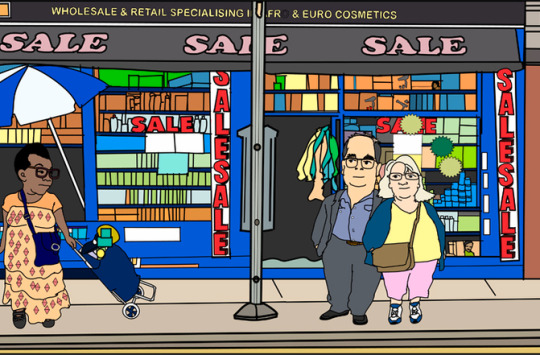
Janette Paris creates bright and punching strip comics and animations based in Peckham. Although I am not a big fan of the style of her work, I appreciate how effective this medium is at telling a story concisely.
The Paper Cinema- PAPER ANIMATION
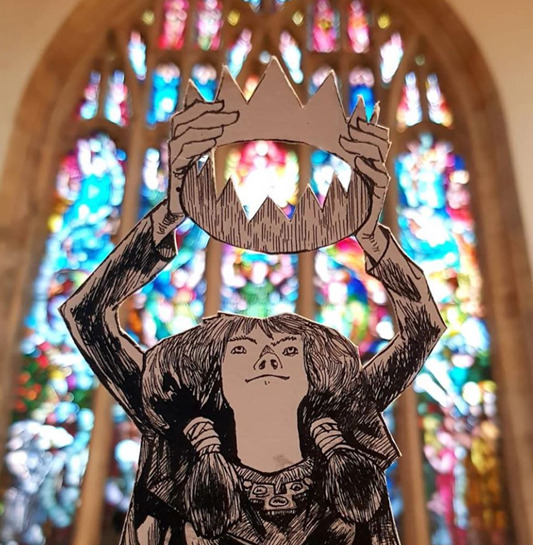
This was my favourite reference artist given by the brief. The Paper Cinema is a company who make films, mostly of classics or Shakespeare, using paper. the paper is moved freely in front of the camera, not using stop motion, and cleverly manipulated to tell the story. I absolutely love the aesthetic of this piece and am inspired by it to possibly make a film.

Manga Kamishibai- AN ILLUSTRATED ‘SLIDESHOW’

Kamishibai (Japanese: 紙芝居, "paper play") is a form of Japanese street theatre and storytelling that was popular during the Depression of the 1930s and the post-war period in Japan.
Kamishibai was told by a kamishibaiya ("kamishibai narrator") who travelled to street corners with sets of illustrated boards that they placed in a miniature stage-like device and narrated the story by changing each image.
I like the idea of this as an almost hand- illustrated television. I think this style of storytelling would work well at the event, however you have to have the confidence to embody the role of narrator, which I unfortunately cannot do.
Samizdat- SELF PUBLISHED BOOKS/PERIODICALS
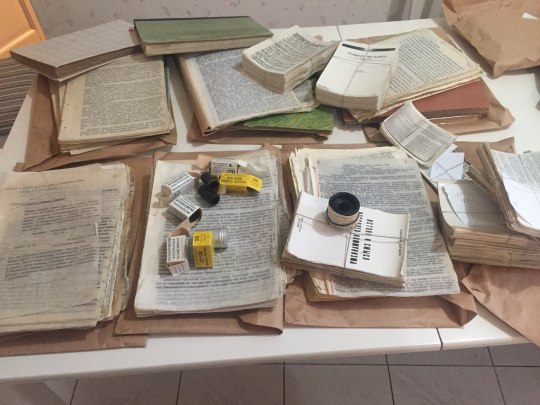
Samizdat ("self-publishing") in which individuals reproduced censored and underground publications by hand and passed the documents from reader to reader. This grassroots practice to evade official Soviet censorship was fraught with danger, as harsh punishments were meted out to people caught possessing or copying censored materials. Vladimir Bukovsky summarized it as follows: "Samizdat: I write it myself, edit it myself, censor it myself, publish it myself, distribute it myself, and spend time in prison for it myself."
This is an interesting format of storytelling because it requires the use of reproduction through multiple people, perhaps producing a sort of Chinese whispers style warping of the final document. I like the idea of the story evolving and being told through reproductions. However, I don’t think any of the stories I have collected from the ice rink are really appropriate for this form of storytelling.
Broadsides- NEWSPAPER STYLE

Elizabethan poetry ‘ballads’ where produced on large sheets in the paper called ‘broadsides’. they were accompanied by gorgeously stylised illustrations. I think this is an interesting way to possibly tell a story- perhaps even in ballad form! however I’m not sure how good this would be for an event as it isn’t very interactive.
Theatre- PERFORMANCE ART

Long has the art of theatre been used to tell stories. Looking into it, I could use multiple elements of theatre, without using theatre itself, to tell stories, for example the sets, staging and costumes, tell stories for themselves.
Spoken Word/ Rap songs- MUSIC AS A WAY TO TELL STORIES
The Liverpool Poets are a number of influential 1960s poets from Liverpool, England, influenced by 1950s Beat poetry. They were involved in the 1960s Liverpool scene that gave rise to The Beatles.
Their work is characterised by its directness of expression, simplicity of language, suitability for live performance and concern for contemporary subjects and references. There is often humour, but the full range of human experience and emotion is addressed.
ANOTHER EXAMPLE:
Pussy Riot is a Russian feminist protest punk rock group based in Moscow. Founded in August 2011, it has had a variable membership of approximately 11 women [1] ranging in age from about 20 to 33 (as of 2012).[2] The group staged unauthorized provocative guerrilla performances in public places, performances that were filmed as music videos and posted on the Internet.[3] The collective's lyrical themes included feminism, LGBT rights, and opposition to Russian President Vladimir Putin, whom the group considered to be a dictator, and his policies.[2] These themes also encompassed Putin's links to the leadership of the Russian Orthodox Church
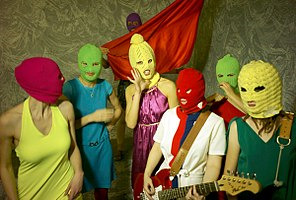
Music is a very powerful tool to get across emotion in the telling of stories, however, I don’t have any musical bones in my body so this isn’t really an option for me!
Shadow Puppetry- PERFORMANCE WITH PROPS
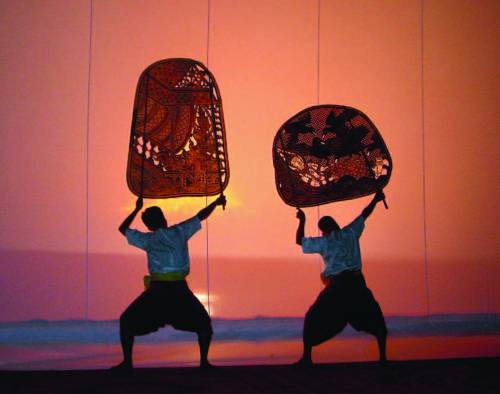
The Sbek Thom is a Khmer shadow theatre featuring twometre high, non-articulated puppets made of leather openwork. Dating from before the Angkorian period, the Sbek Thom, along with the Royal Ballet and mask theatre, is considered sacred. Dedicated to the divinities, performances could only take place on specific occasions three or four times a year, such as the Khmer New Year, the King’s birthday or the veneration of famous people. After the fall of Angkor in the fifteenth century, the shadow theatre evolved beyond a ritualistic activity to become an artistic form, while retaining its ceremonial dimension.
The puppets are made from a single piece of leather in a special ceremony for each character representing gods and deities. The hides are dyed with a solution made from the bark of the Kandaol tree. The artisan draws the desired figure on the tanned hide, then cuts it out and paints it before attaching it to two bamboo sticks enabling the dancer to control the puppet.
Shadow puppetry in all of its forms has long been a fascination of mine, along with simple puppetry itself. I think it is a really interesting way of telling a story and it is something I would consider for my project.
Immersive Theatre - THEATRE WITH A THEMED ENVIRONMENT
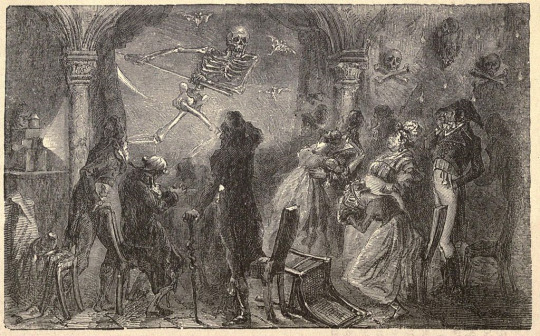
Phantasmagoria was a form of horror theatre that used one or more magic lanterns to project frightening images such as skeletons, demons, and ghosts onto walls, smoke, or semi-transparent screens, typically using rear projection to keep the lantern out of sight. Mobile or portable projectors were used, allowing the projected image to move and change size on the screen, and multiple projecting devices allowed for quick switching of different images.
In many shows the use of spooky decoration, total darkness, (auto-)suggestive verbal presentation, and sound effects were also key elements. Some shows added all kinds of sensory stimulation, including smells and electric shocks. Even required fasting, fatigue (late shows) and drugs have been mentioned as methods of making sure spectators would be more convinced of what they saw. The shows started under the guise of actual séances in Germany in the late 18th century, and gained popularity through most of Europe (including Britain) throughout the 19th century.
Theming in an environment, for example stage sets of theme parks, has long been a passion of mine. The more immersive the better. I love the idea of this type of production and think I might use elements of it in my own work.
Sideshows
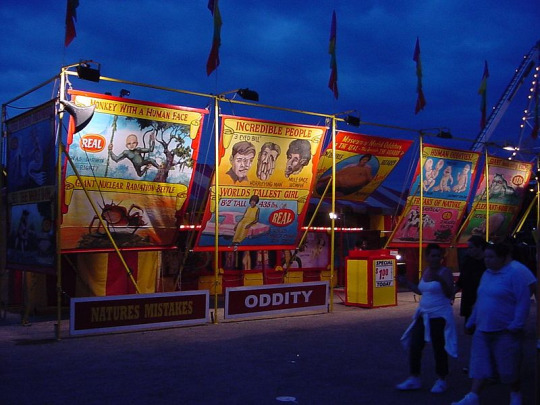
In North America, a sideshow is an extra, secondary production associated with a circus, carnival, fair, or other such attraction.
I think the most interesting thig here are the painted signs leading you to the sideshows. They are such an old fashioned art form. I have previously done a huge project on circus signage so am very interested in painting signage for my project too!
1 note
·
View note
Photo

So, you want to adapt Little Women for the screen.
There’s quite a challenge ahead of you, Gentle Readers.
Might I help get you started?
What, you might ask are my own bona fides in suggesting that I might have the right to hold forth on such a topic? Very well, I first read Little Women in 1983. The first of countless times I have read it. Actually, I collect copies of it, and buy interesting ones whenever I see them. I’ve seen more than a few adaptations of it.

The cover of my first copy. A giant volume, it was highly impractical to carry around. I did it anyway.
An initial challenge, any screen writer will tell you, is sheer length. Little Women was originally published as two separate books. So, an initial novel, and a sequel. By 1880, the two volumes were forever published as one.
Not only does this mean lots of pages and plot needing weeded out of your script, but it also means you’re going to have two climaxes and two denouements (seems about right for a female novel, yeah?), another challenge when adapting the two stories into a single film. (Imagine having to create a single story/plot from Philosopher’s Stone AND Chamber of Secrets).
Inevitably, what generally happens in past adaptations is that Part II gets greatly compressed and short-changed (and I do not doubt, Gentle Readers, creates some of the dissatisfaction among viewers and fans where the handling of Laurie’s proposal and the latter adolescence of characters and their romances/mates don’t land as they might if spent more time with).

Actual illustration of Book One (on the left) and Book Two (on the right) once adapted for film.
According to Wikipedia: The book has been adapted for cinema; twice as silent film and four times with sound in 1933, 1949, 1978 and 1994. Six television series were made, including four by the BBC—1950, 1958, 1970, and 2017. Two anime series were made in Japan during the 1980s. A musical version opened on Broadway in 2005. An American opera version in 1998 has been performed internationally and filmed for broadcast on US television in 2001. Greta Gerwig is directing a new rendition of the novel, set to be released 2019.

I could not hit “Add to Watchlist” fast enough.
So, the list of folks attempting to tackle Little Women is a long one, and not always a successful one. Some elements of the story are always going to play well, and frankly, be hard to mess up too much. But others? Others have some real sticking-points.
I’m not here to critique individual versions of adaptations today, Gentle Readers.
I’m just here to muse on the Big Questions that need solid answers when you’re ready to take on writing your adaptation.
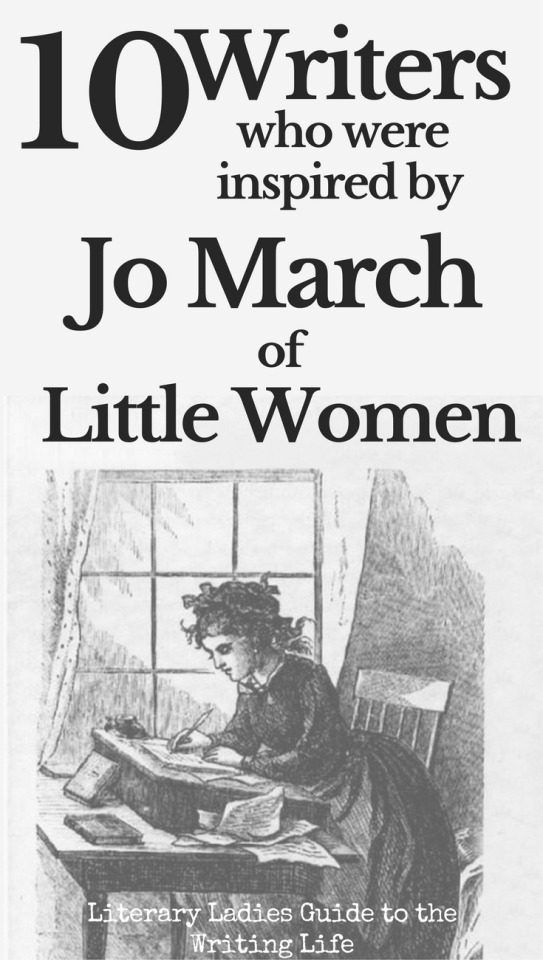
Someone contact them, I demand a recount.
1. How much of the true lives of the Alcott family will we include?
It’s no secret at this point that Alcott took a lot of inspiration from her real life. But how much do we include? Do we have Thoreau invited over for dinner? Do we address some of the more radical notions of the Alcotts’? Do we just go ahead and make Father in the novel like Bronson in real life?
a. How to explain/not explain the war and its effect on their lives
For contemporary audiences and readers, the incredibly matter-of-factness of the Civil War taking place deep in the background of the story will not resonate as much as it would to readers back in the day (It plays a bit like the Blitz in The Lion, the Witch, and the Wardrobe]. Perhaps it might be a good idea to bring it closer to the fore, beyond merely showing the girls in hoops, and coming across the occasional newspaper story or quietly dropped reference to a battle.
b. How to address or not address the March’s contemporarily confusing socio-economic position (that of ‘genteel penury’)
Gentle people now in reduced circumstances is a tough sell intellectually when 2019 can allow most everyone to disguise their financial situation through extensive credit and things like those housing bubble mortgages given to lots of Americans. It’s going to be necessary at some point to explain or show how the Marchs, who have so little themselves, have (to our 2019-eyes) pretty clothes, a large, cozy house, the ability to take food and minister to the (much) poor(er) Hummels, and a house servant; Hannah. The humiliating fact that they can’t buy new gloves for a party does not...exactly track in the twenty-first century.
They’re much worse-off than the Bennets of Longbourne, whose financial crisis is on the horizon, but how can you show that to viewers unfamiliar with the notion of life as a fallen-from-wealth family?
2. The persistent problematic-ness of Amy/Laurie
I will call to mind one adaptation, here, and Kirsten Dunst’s performance in particular. Singlehandedly, at the age of only *10*, she manages to sell the potential of not only Amy, but Amy/Laurie like no one else this tumblerian has ever seen. What a tragedy the film couldn’t have waited for her to grow up enough to also play Amy in the film’s second half.
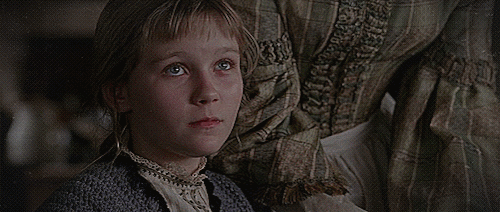
In a world where perfect casting is rarely obtainable, this child should have been nominated for Oscar. She out-performs every Amy March before or since, ad infinitum.
Like many of the romantic partnerships, which other than Jo/Teddy (which is not presented as romantic in Book One) are included only in Book Two, films front-loaded with Book One (I can’t think of one I’ve seen that wasn’t) find themselves racing to a conclusion, and every one of the three couples suffers in presentation and allowing enough time for viewers to be ‘courted’ by them into liking them.
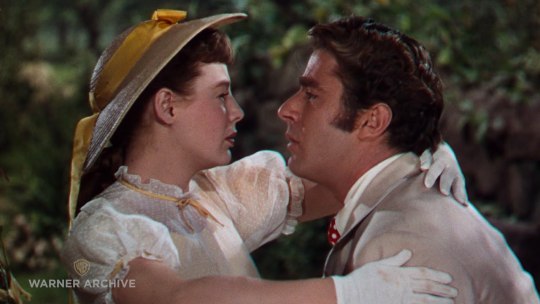
There’s simply not enough time left to work on all of them. So, it becomes a decision of which one is more important. Traditionally, as Brooke/Meg happens first, they get some character beats, but once Jo turns down Teddy...
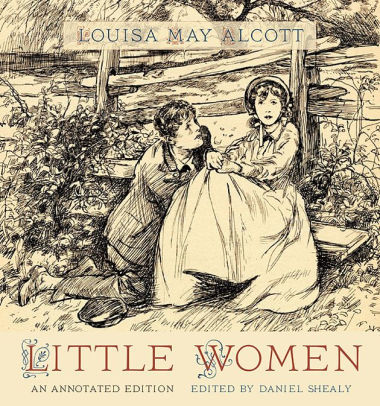
I can hear the screams of horror across the ages.
...adaptations become a fight between showing Amy/Laurie or Jo/Bhaer, yet both of which are true surprises to viewers not familiar with the story, and who need time to warm up and be seduced by these new pairings.
(Mind you, I do think Bhaer and Jo should sneak up on a viewer/reader, but there still have to be signs planted here and there that make it make sense when it actually does happen.)
3. The age and age progression of the girls
Per the book, the story begins with Meg 16, Jo 15, Beth 13, and Amy 12 (aside: poor Marmee).
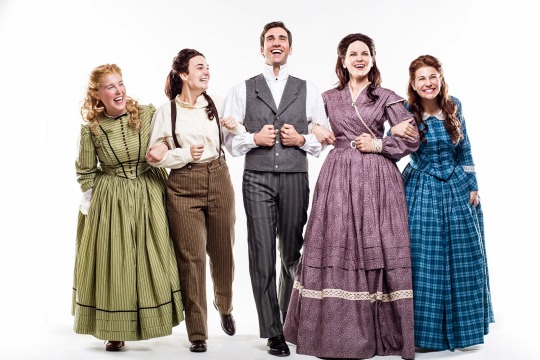
A clear example of...impractical* casting for teenagers. (And Jo! In trousers!?)
* but perhaps necessary for community theatre
As I mentioned a few lines ago, Amy becomes the most difficult to cast, here, as it’s unlikely a person can play both 12 and the age of Amy when she accepts Laurie. Amy may be only 16 or so when she accepts Laurie, but contemporary viewers are probably going to need a little more assurance she’s not a child bride by her looking more mature than 16.
Beth is frequently cast older, which is also troublesome. She’s 16 at most when she dies, and has been ill for some time. (So, easy to assume she wasn’t growing rapidly.)
Jo has to be able to play age 15 to 25+.

Is that meant to be Jo on the left? Does that make Susan Dey Amy?
Anyway, this production has the luxury of doing better on the ages of the girls. And they’ve got the inimitable Greer Garson as Aunt March!
Actors chosen can’t only be made-up to pass for certain ages, they also have to convince us they’re playing dress-up in the garret in the early portion of the film.
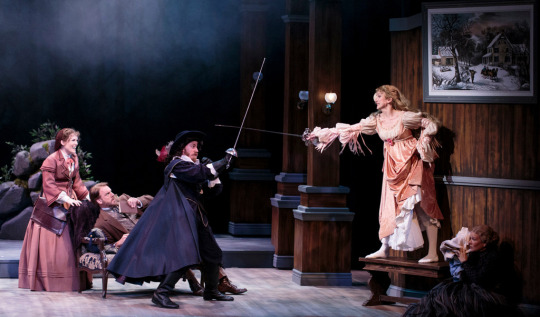
In fact, Jo in particular with her harum-scarum ways isn’t deliberately trying to make constant mistakes and faux pas. She’s a kid who hasn’t yet grown up, with a kid’s energy and unbridled sincerity. Convince us of that.
4. How to show both the importance and the growth of Jo’s writing
Filming someone writing is rarely moving to watch, and what’s more, writing is so misunderstood as a pastime or even a vocation, it doesn’t easily lend itself to being captivating when shown on-screen. And yet Jo’s writing is not only vital to the story, the growth and expression she finds in it are so deeply important to her character, and later to her romance plot with Bhaer. It’s got to be shown, and more than once. Moreso, or at least as much so as her temper, her mouth, and her lioness-like care for her sisters, it IS who she is.
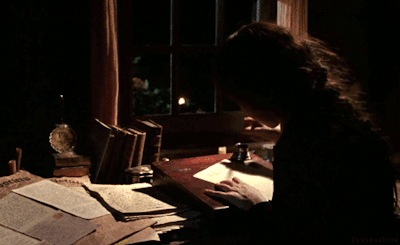
Where’s the silly hat?
5. Flawed female characters that are meant to confront and wrestle with those flaws
Well, this is a big one, here. It seems to me we’re sort of operating by 2019 where that old saw of [man] girl vs. self isn’t really written about or shown. Our society at large has become very vocal about whoever we are being awesome and “never change”.
Which is just about as far from the notions in Little Women as one could get. Every one of the ‘women’ has something they need to work on, to grow and improve about themselves. From Meg not being able to get over their loss of money and status (remembered from when she was younger), to Amy’s dissatisfaction and constant desire to fine things, to Beth’s introversion, to Jo’s temper and intolerance of those who aren’t as bold and rebellious against society as her, and Jo’s inability to accept the change that will constantly be coming into all their lives as they grow.

Nasty!
The Little Women Alcott wrote had lessons to learn, and directions to grow, contrary to what their gut reactions might be. You can call that a moralistic take on the novel, but you can’t argue that Jo has to change, and is expected to be her own instigator of that change within the novel(s). [It does seem like anymore in films that the only person we expect to change bad habits or wrong ways of being are actual ‘bad guys’/villains. And sometimes not even them.]
6. Friedrich Bhaer
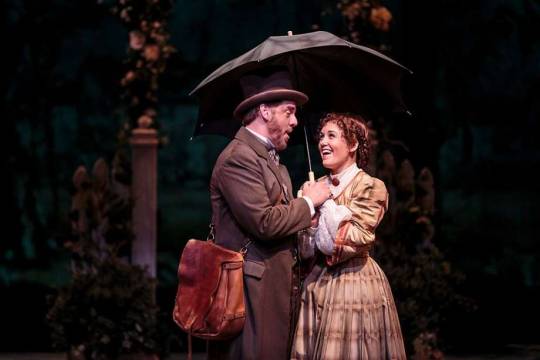
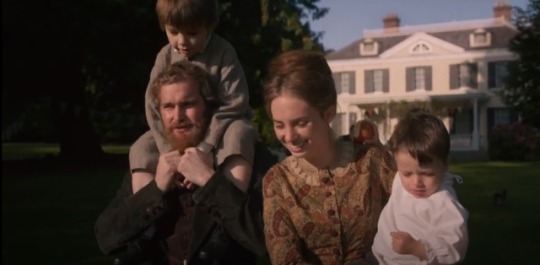
Well, that’s a mouthful. I don’t doubt that it always has been. The single, fan-dividing phrase of female literature. Am I right?
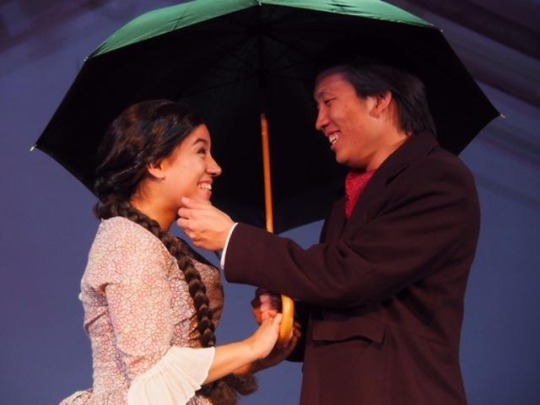
Doing for umbrella representation until Gene Kelly came along.
You know the story, right? That Alcott was so DONE with readers after Book One assuming and expecting Jo and Teddy to live happily ever after, she was so frustrated (she had never wanted, nor intended for that to happen) with all the shipping she built a Bhaer bomb.

@grrlinthefireplace would climb that.
And it’s still exploding readers’ and viewers’ minds today.
Why Professor Bhaer is the perfect match for Jo, and why their marriage and life together makes ultimate sense is certainly a post for another time, but I will say that if you’re still sore about it, take some time and reread the book as an adult, and see if you don’t also come to see the eminent sense in it.
That said, in any satisfying and successful adaptation, you’ve got to work hard to sell the man your heroine chooses over Laurie. Laurie’s had all of Book One and a good three-quarters of Book Two to endear himself to readers. Who’s this guy?
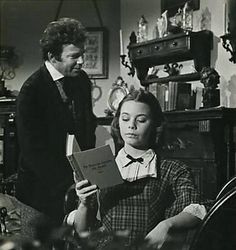
Well, yes, that’s William Shatner...as Professor Bhaer.
This guy isn’t good enough for Jo. This is nonsense. “Weird old guy with an uncomfortable age gap with my fave.” Are not the sort of things you’re going to want to read in reviews.
First, you’ve got to cast him right. Hollywood’s not *overly* worried about distressing RL gaps in ages between their actresses and actors, you might know, and beards are actually pretty in right now. Bhaer’s not a babe by any means, but he’s got an accent he can work. And he’s in love with our fave.
Think an Alan Rickman-type (I know he’s not German), did you see how hot Kurt Russell made Santa Claus in that Netflix Christmas movie? Jeff Bridges, Pierce Brosnan? Probably all too old.
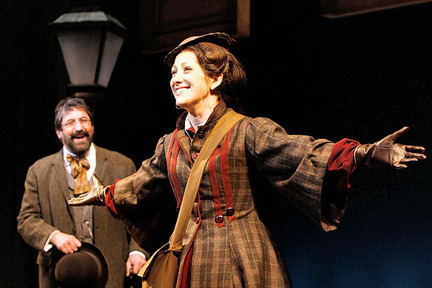
Bhaer’s actually described as “middle-aged”, which means 40ish, to Jo’s 25 (when she accepts him). You know who’s 40ish in Hollywood? Gerard Butler, Hugh Jackman, Ewan McGregor, most of Hollywood’s Chrises, RDJ for Pete’s sake is 53. Give him a beard, and awkward social presence tick, and get him working on that accent, and I guarantee your audience will buy Jo’s attraction to him, and create a Twitter for his umbrella.
In the end, Bhaer is key to understanding that the novel isn’t trying to transform Jo into a woman who will fit into Teddy’s wealthy life and the social circles he has no plans to turn his back on. Bhaer is literally the embodiment of Jo making choices that she learns (and I daresay we are meant to learn) are right for her. She finds a man comfortable with who she is, who is in love with her brain as much as with the rest of her, who sees their coupling as a joint project, and who wants her to be the best her. (cough, cough, Gilbert Blythe prototype)
You’ve got to get him right, or what’s come before gets lost in dissatisfaction for Jo’s final, epic choice.

Oh, look, a nice picture of a charismatic, bearded German actor. How did that get here?
Let’s be succinct here in the end, Gentle Reader. Little Women (Books One and Two) and Little Men and Jo’s Boys would make a splendid series. (Such as Anne with an E), there’s certainly enough episodic drama and plot to go around.
Keep that in mind when planning out your adaptation.
What film adaptation is your favorite, and why?
106 notes
·
View notes
Text
THE MARRIAGE LICENSE ERROR
January 21, 1949

“Marriage License Error” (aka “Marriage License”) is episode #27 of the radio series MY FAVORITE HUSBAND broadcast on January 21, 1949 over the Armed Forces Radio Network (AFN).
Synopsis ~ Liz and George find their marriage license and discover that instead of "George H. Cooper," it says "George C. Hooper." Now Liz is convinced that she and George aren't legally married!

Portions of this radio show served as the basis for “The Marriage License” (ILL S1;E26) filmed on February 28, 1952 and aired on April 7, 1952, on CBS-TV. On television, the Ricardo’s marriage license mistakenly read “Bicardi” instead of “Ricardo”.
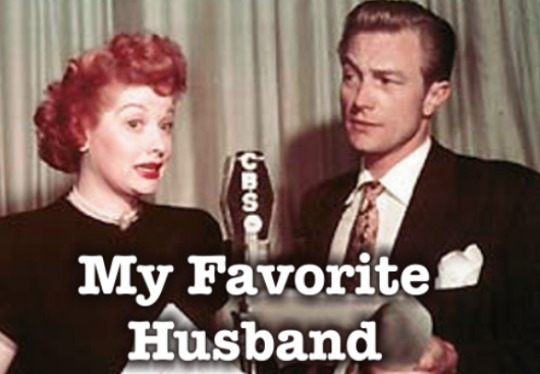
“My Favorite Husband” was based on the novels Mr. and Mrs. Cugat, the Record of a Happy Marriage (1940) and Outside Eden (1945) by Isabel Scott Rorick, which had previously been adapted into the film Are Husbands Necessary? (1942). “My Favorite Husband” was first broadcast as a one-time special on July 5, 1948. Lucille Ball and Lee Bowman played the characters of Liz and George Cugat, and a positive response to this broadcast convinced CBS to launch “My Favorite Husband” as a series. Bowman was not available Richard Denning was cast as George. On January 7, 1949, confusion with bandleader Xavier Cugat prompted a name change to Cooper. On this same episode Jell-O became its sponsor. A total of 124 episodes of the program aired from July 23, 1948 through March 31, 1951. After about ten episodes had been written, writers Fox and Davenport departed and three new writers took over – Bob Carroll, Jr., Madelyn Pugh, and head writer/producer Jess Oppenheimer. In March 1949 Gale Gordon took over the existing role of George’s boss, Rudolph Atterbury, and Bea Benadaret was added as his wife, Iris. CBS brought “My Favorite Husband” to television in 1953, starring Joan Caulfield and Barry Nelson as Liz and George Cooper. The television version ran two-and-a-half seasons, from September 1953 through December 1955, running concurrently with “I Love Lucy.” It was produced live at CBS Television City for most of its run, until switching to film for a truncated third season filmed (ironically) at Desilu and recasting Liz Cooper with Vanessa Brown.
REGULAR CAST
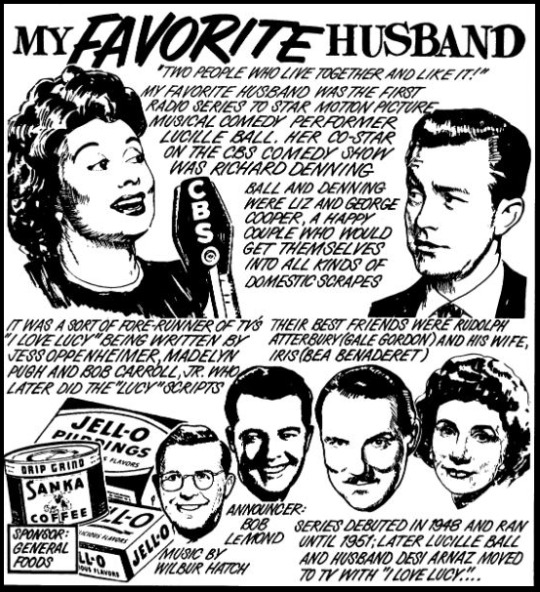
Lucille Ball (Liz Cooper) was born on August 6, 1911 in Jamestown, New York. She began her screen career in 1933 and was known in Hollywood as ‘Queen of the B’s’ due to her many appearances in ‘B’ movies. With Richard Denning, she starred in a radio program titled “My Favorite Husband” which eventually led to the creation of “I Love Lucy,” a television situation comedy in which she co-starred with her real-life husband, Latin bandleader Desi Arnaz. The program was phenomenally successful, allowing the couple to purchase what was once RKO Studios, re-naming it Desilu. When the show ended in 1960 (in an hour-long format known as “The Lucy-Desi Comedy Hour”) so did Lucy and Desi’s marriage. In 1962, hoping to keep Desilu financially solvent, Lucy returned to the sitcom format with “The Lucy Show,” which lasted six seasons. She followed that with a similar sitcom “Here’s Lucy” co-starring with her real-life children, Lucie and Desi Jr., as well as Gale Gordon, who had joined the cast of “The Lucy Show” during season two. Before her death in 1989, Lucy made one more attempt at a sitcom with “Life With Lucy,” also with Gordon.
Richard Denning (George Cooper) was born as Louis Albert Heindrich Denninger Jr., in Poughkeepsie, New York. When he was 18 months old, his family moved to Los Angeles. Plans called for him to take over his father’s garment manufacturing business, but he developed an interest in acting. Denning enlisted in the US Navy during World War II. He is best known for his roles in various science fiction and horror films of the 1950s. Although he teamed with Lucille Ball on radio in “My Favorite Husband,” the two never acted together on screen. While “I Love Lucy” was on the air, he was seen on another CBS TV series, “Mr. & Mrs. North.” From 1968 to 1980 he played the Governor on “Hawaii 5-0″, his final role. He died in 1998 at age 84.
Ruth Perrott (Katie, the Maid) was also later seen on “I Love Lucy.” She first played Mrs. Pomerantz (above right), a member of the surprise investigating committee for the Society Matrons League in “Pioneer Women” (ILL S1;E25), as one of the member of the Wednesday Afternoon Fine Arts League in “Lucy and Ethel Buy the Same Dress” (ILL S3;E3), and also played a nurse when “Lucy Goes to the Hospital” (ILL S2;E16). She died in 1996 at the age of 96.
Announcer Bob LeMond is not heard in this episode as it is part of the American Forces Network and has a different announcer.
Gale Gordon (Rudolph Atterbury) and Bea Benadaret (Iris Atterbury) had not yet joined the cast as regular characters.
GUEST CAST

Frank Nelson (Joe Ridgley) was born on May 6, 1911 (three months before Lucille Ball) in Colorado Springs, Colorado. He started working as a radio announcer at the age of 15. He later appeared on such popular radio shows as “The Great Gildersleeve,” “Burns and Allen,” and “Fibber McGee & Molly”. This is one of his 11 performances on “My Favorite Husband.” On “I Love Lucy” he holds the distinction of being the only actor to play two recurring roles: Freddie Fillmore and Ralph Ramsey, as well as six one-off characters, including the frazzled train conductor in “The Great Train Robbery” (ILL S5;E5), a character he repeated on “The Lucy Show.” Aside from Lucille Ball, Nelson is perhaps most associated with Jack Benny and was a fifteen-year regular on his radio and television programs.

Doris Singleton (Hotel Biltmore Telephone Operator) created the role of Caroline Appleby on “I Love Lucy,” although she was known as Lillian Appleby in the first of her ten appearances. She made two appearances on “The Lucy Show.” Singleton played a secretary in the first episode of “Here’s Lucy” and was meant to be a series regular, but her role was written out to concentrate on Lucy Carter’s family life. She did two more episodes of the series.
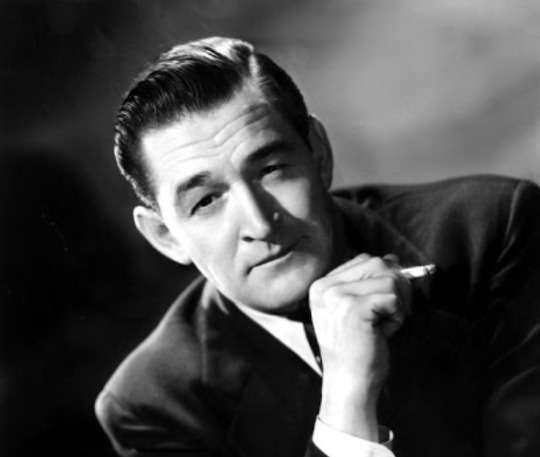
Ted de Corsia (Police Officer) was an actor in touring companies and on radio before making a memorable film debut as the killer in The Lady from Shanghai (1947). De Corsia's New York street demeanor and gravelly voice assured him steady work playing street thugs, gang leaders or organized-crime bosses. On radio he starred in the CBS series "Pursuit" (1949-50). Two years after this episode of “My Favorite Husband,” he appeared with Lucille Ball on the radio show “The Golden Touch.”
The actor voicing the role of Paul Buchanan is not credited and has not been identified.
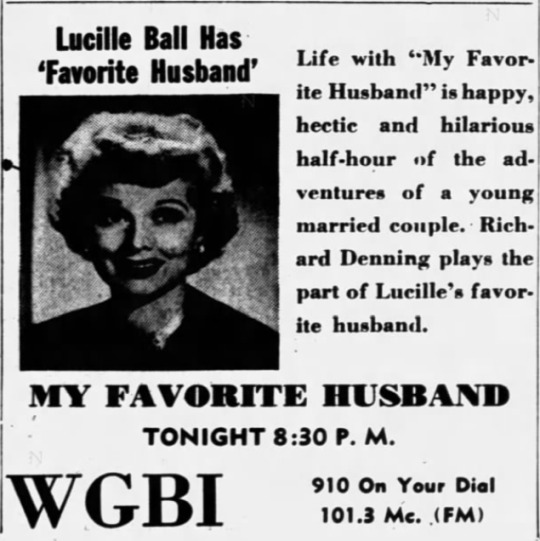
EPISODE
The Coopers are spending the evening in the living room reading the newspapers. Liz is doing the crossword puzzle, while George scans the headlines.
GEORGE: “Well, it looks like the inauguration came off alright.”
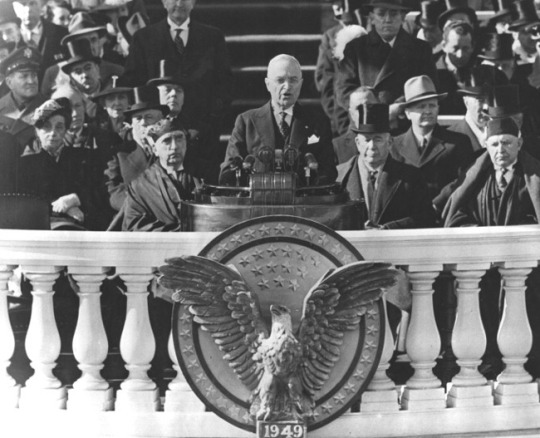
George is referring to the second inauguration of incumbent President Harry S. Truman, which happened in Washington DC the previous day. It ushered in Truman’s second term in office. It was the first televised U.S. presidential inauguration and the first with an air parade.
Liz insists that crosswords build her vocabulary. George quizzes her on current events.
GEORGE: “Where did the President take his oath of office?”
LIZ: “On a special platform built in front of the capitol building.
GEORGE: “How did you happen to know that?”
LIZ: “It showed through the hole when I cut out the crossword puzzle.”
GEORGE: “Try this: who administered the oath?”
LIZ: “What?”

The familiar trope of husbands being engrossed in the morning papers to the dismay of their wives takes a slightly different spin here, but was continued well into “I Love Lucy.” The answer that George is looking for is that Chief Justice Fred M. Vinson administered the presidential oath of office that day in 1949.
Through the hole, Liz recognizes the name of Paul Buchanan, who is in the paper because he was elected president at the jewelers convention. Liz recalls dating him in high school. He played tuba in the school band. Liz says she might have married but for his tuba playing.
Liz says that if she had married Paul she might have gotten an engagement ring. Instead, George couldn’t afford a ring and gave her a sweat shirt with his initials on it. George says the initials actually stood for Gym Class!
LIZ: “I was lovely! I was engaged! I was dressed like Maxie Rosenbloom!”
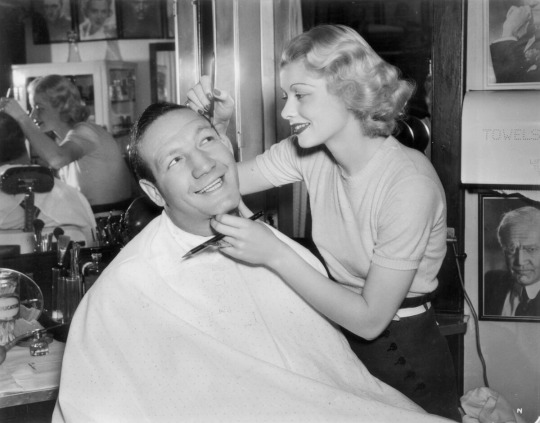
Max Everitt Rosenbloom (1907-76) was a professional boxer, actor, and television personality. In 1948 he played a truck driver in the Paulette Goddard film Hazard. Nicknamed “Slapsie Maxie”, he had appeared in the film Muss ‘Em Up (1936) in which a blonde Lucille Ball was a background performer. She posed with him for the above publicity shot, helping him apply his make-up!
Liz senses that George is still upset about the ring, so she sits on his lap and they cuddle and kiss. Liz opens their scrapbook, looking at their wedding photos. She sees her marriage license.
LIZ: “On this date, Elizabeth Elliott was married to George C. Hooper!”
Liz panics thinking that their license may be invalid - and they might not even be legally married! As soon as the Sheridan Falls City Hall opens, Liz intends to go down there personally and find out for sure!
Unbeknownst to Liz, George calls his friend at the license bureau, Joe Ridgley (Frank Nelson). He tells Joe that he wants him to play a joke on Liz, and tell her that they are not really married! Joe agrees.
Liz arrives at the bureau and explains to Mr. Ridgley about the error. He tells Liz that it does indeed matter. He refers to her as “Miss Elliott” and confirms that she hasn’t been married to George for ten years!
Liz returns home. When George goes to kiss her - she says that she is no longer his to touch!
LIZ: “The man at the license bureau put the padlock on our wedlock.”
Liz insists they go right down to the license bureau and get re-married. George - having some fun at her expense - hesitates. Liz is as upset as she is angry! Just then, Katie the Maid takes Liz aside into the kitchen to tell her that it’s all a joke between George and Joe. Liz decides to get revenge for his prank.
Liz goes back into the living room and George suddenly confesses to his joke - but when he describes Joe Ridgley, Liz says that he is not describing the man she spoke to at all! Which means that they really aren’t married after all! George wants to go right down to City Hall and re-marry, but Liz (teasing him along even further) says not so fast - she wants to be single a little longer!
Liz picks up the phone to call Paul Buchanan to ask him out on a date. She reminds him that she was called “Queen of the Rumble Seat”!
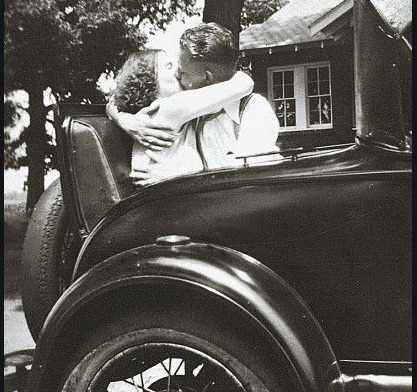
A rumble seat was an additional padded passenger seat that popped up from the rear of the vehicle, usually just big enough for two. This led it to becoming synonymous with romantic trysts!
Liz knows that George can’t hear Paul on the other end as he protests that he is married with six kids! He abruptly hangs up, but Liz continues her staged phone conversation with the hotel operator (Doris Singleton). Liz says that she will meet him at the Flamingo Room of the Biltmore.
In the kitchen, Liz tells Katie that while George thinks she is on a date with Paul Buchanan at the Biltmore, she and Katie will actually be watching Humphrey Bogart at the Strand movie theater.

In January 1949, Bogart’s most recent film would have been Key Largo, released in mid-summer 1948. It went on to win an Oscar for Claire Trevor. Humphrey Bogart never appeared on screen with Lucille Ball. However, in “Ricky’s Movie Offer” (ILL S4;E5) Desi Arnaz does an impression of Bogart and in “Lucy and the Andrews Sisters” (HL S2;E6) Lucy blows a kiss to a large poster of Bogart from the movie Casablanca.
Coming out of the Strand later that evening, Liz and Katie notice a crowd in front of the Biltmore Hotel. Katie thinks it might be a wreck!
LIZ: “When you see a crowd in front of a window these days, it isn’t a wreck, it’s television!”
KATIE: “Oh, well maybe they’re showing a wrestling match!”
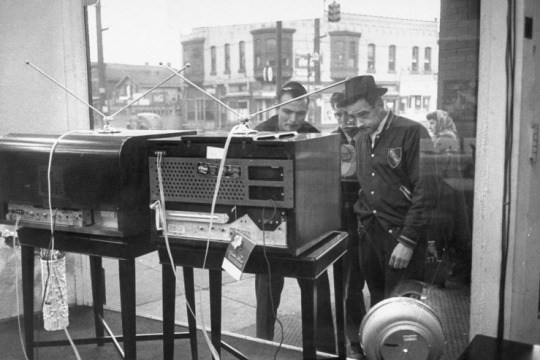
Before television sets became affordable to the general public, it was not uncommon to find people gathered on the sidewalk in front of a store window to view it from the street.
LIZ: “Katie it is wrestling! There’s gorgeous George!”
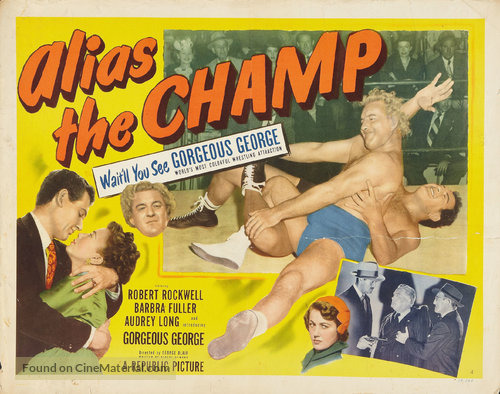
Liz is referring to her husband, George but wrestling matches were very popular on early television, producing such colorful wrestlers as Gorgeous George. George Raymond Wagner (1915–63), was known as Gorgeous George because of his long blonde hair. He was mentioned on “I Love Lucy” in “Pioneer Women” (ILL S1;E25) and “Ricky’s Movie Offer” (ILL S4;E6). In 1949, Republic Pictures released a film starring Gorgeous George.
A Policeman (Ted de Corsia) is breaking up a brawl between George Cooper and Paul Buchanan. Paul is nothing like Liz remembered: bald, fat and with a black eye. Paul remembers George from school. Liz is delighted having two men fighting over her. George spots Liz in the crowd. When George insists Liz is his wife, Liz claims she never saw him before.
When the cop wants to arrest George, Liz pretends to be from Brooklyn (Myrtle Avenue) to talk him out of it. She insists that George buy her an engagement ring (from Paul) to get out of going to jail. The office gladly agrees - if George will properly propose on one knee first! Liz insists he use her ‘pet’ name.
GEORGE: “Will you marry me... toodly-woodly-ums!”
COP: “When you gonna get married?”
LIZ: “Ten years ago!”
COP: “Why that’s impossible!”
LIZ: “Who cares! I’ve got back my favorite husband!”
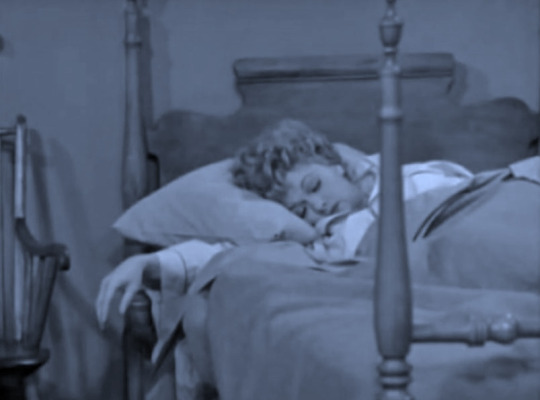
In the bedtime tag, Liz asks George to get up and get her a glass of warm milk. After bickering about it for a moment, George reluctantly agrees, stubbing his toe on the chair. By the time he finds his slippers, Liz is snoring, fast asleep.
GEORGE: “How do you like that? Goodnight, Liz.”
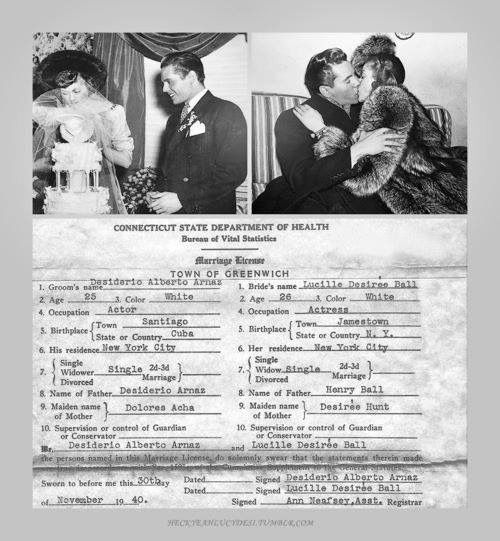
#Marriage License#My Favorite Husband#I Love Lucy#Lucille Ball#Richard Denning#Frank Nelson#Ruth Perrott#CBS Radio#Doris Singleton#Tony Di Corsia#keychain#Humphrey Bogart#Gorgeous George#Maxie Rosenbloom#TV#Harry S. Truman#Rumble Seat#1949
2 notes
·
View notes
Text
The Case of The Chemical Syndicate

DETECTIVE COMICS #27
MAY 1939
BY BILL FINGER, BOB KANE, JERRY SIEGEL, JOE SHUSTER, JIM CHAMBER AND CHARLES BIRO
SYNOPSIS (FROM DC WIKIA)
Commissioner Gordon relaxes at home entertaining his young socialite friend Bruce Wayne. Wayne asks if anything exciting has happened lately, and Gordon explains that a fellow called the "Bat-Man" is puzzling him. Gordon receives a call that chemical manufacturer Lambert has been found murdered. They have Lambert's son in custody, whose fingerprints were found on the knife. Gordon invites Bruce Wayne to the Lambert mansion with him, and Bruce Wayne says he has nothing better to do.

When they arrive at the crime scene, young Lambert insists he is innocent. The lad explains that he arrived home early and saw his father lying on the floor. When he entered the library, he saw a figure escaping out the window. He pulled a knife out of his father's back, and his father's last word was "contract." Lambert's son recalls that his father had three associates, Alfred Stryker, Paul Rogers, and Steve Crane. Steve Crane calls Gordon on the phone. Lambert told Crane that he had received a death threat the previous day. Crane has received a similar death threat, and asks for police protection. Bruce Wayne decides to go home, and Gordon rushes over to the Crane residence.

Steven Crane is killed by a gunman who enters through the window. The thug and his partner steal a paper from Crane and climb onto the roof. They are confronted by a figure they recognize as the Bat-Man, standing in the moonlight. The Bat-Man punches the first thug out, then grabs the second one in a headlock and throws him off the second-story roof. He grabs the paper and escapes as Gordon is pulling up. The GCPD try to arrest the Bat-Man, but they are unable to catch him. Gordon learns that Crane has been murdered, and moves on to the next business partner. The Bat-Man smiles when he reads the paper he stole, and drives off in his automobile.

Paul Rogers visits the laboratory of Alfred Stryker, having learned of Lambert's death by news broadcast. Stryker's assistant Jennings clubs Rogers over the head and ties him up. Jennings explains that he will lower a gas chamber over Rogers and kill him the same way he puts animals to sleep. Jennings leaves to activate the gas. The Bat-Man leaps into the room through an open transom. The Bat-Man grabs a wrench and dives inside the gas chamber before it closes.
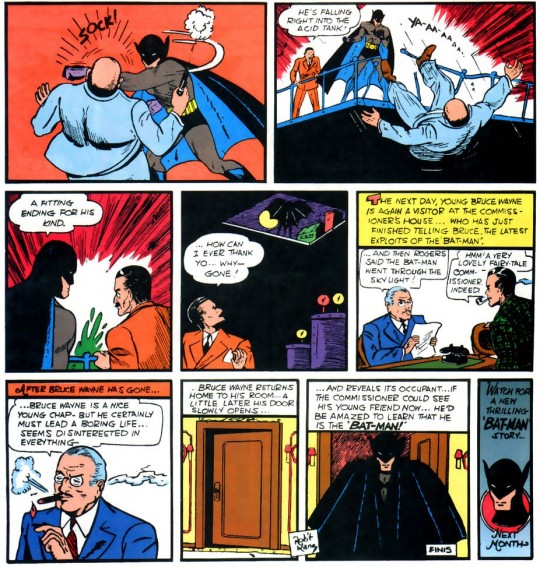
He plugs the gas jet with a handkerchief, and busts through the glass with his wrench. Jennings returns and tries to pull a gun on the Bat-Man, but the Bat-Man punches him in the face really hard. Alfred Stryker enters and demands to know what happened. When Rogers explains that Jennings tried to kill him, Stryker pulls out a knife to finish the job. The Bat-Man is hiding in the shadows, and he grabs Stryker from behind to stop him.
The Bat-Man explains to Rogers that they were all partners in the Apex Chemical Corporation. Stryker had made secret contracts with all of them to pay them a sum of money each year until he owned the business. He grew tired of waiting and decided to kill them so he wouldn't have to pay. Stryker breaks out of the Bat-Man's grip and pulls a gun on him. The Bat-Man punches Stryker so hard in the face that Stryker breaks through a railing and falls into a tank of acid. The Bat-Man remarks that this is a fitting end for his kind, and leaves via transom. Rogers tries to thank the Bat-Man, but he is already gone.
Later at his house, Commissioner Gordon relates this story to Bruce Wayne. Bruce remarks that this is a lovely fairy tale, and leaves. Gordon thinks to himself that Bruce Wayne is a nice young chap, but he seems to lead a very boring life. Bruce returns home to Wayne Manor, where it's revealed that he is in fact the Bat-Man.
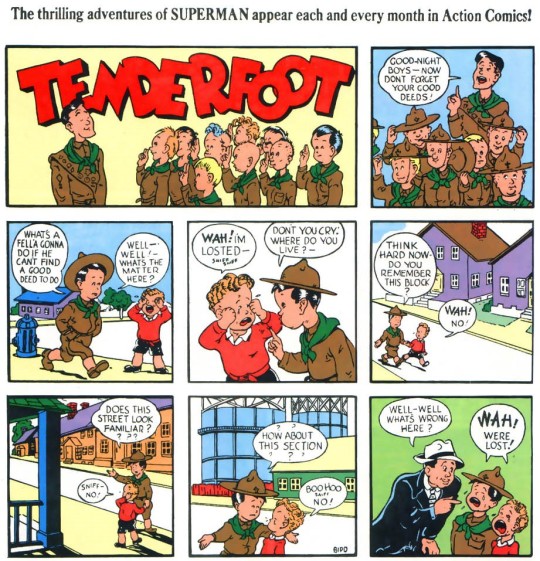
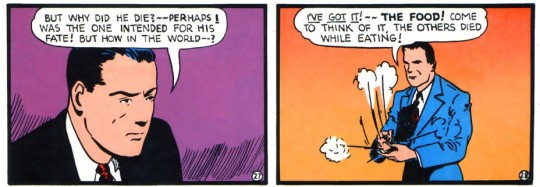
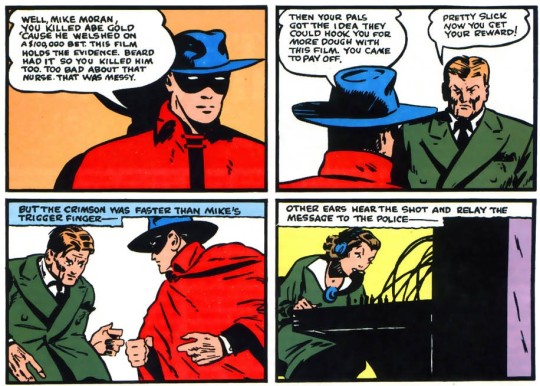
CONTEXT


There is a lot of bad blood behind this creation, so stay with me and we shall go through this...
So the legend says that Bob Kane created Batman when he was a minor and with the help of writer Bill Finger they did the story that was published in Detective Comics. And that is just a legend.
It’s hard to tell if Kane was a minor when he signed his contract to National. He was born in 1915, and that would make him 20 at the time National/Wheeler-Nicholson started the business. We know for sure he wasn’t the “creator” of Batman.
Comics historian Ron Goulart has referred to Batman as the "creation of artist Bob Kane and writer Bill Finger". Bill Finger said this about Bob Kane:
Kane had an idea for a character called 'Batman', and he'd like me to see the drawings. I went over to Kane's, and he had drawn a character who looked very much like Superman with kind of ... reddish tights, I believe, with boots ... no gloves, no gauntlets ... with a small Domino Mask, swinging on a rope. He had two stiff wings that were sticking out, looking like bat wings. And under it was a big sign ... BATMAN.
Finger offered such suggestions as giving the character a cowl instead of the domino mask, a cape instead of wings, adding gloves, and removing the red sections from the original costume. He later said his suggestions were influenced by Lee Falk's popular The Phantom, a syndicated newspaper comic strip character with which Kane was familiar as well, Finger named the character Bruce Wayne after Robert Bruce the Scottish Patriot.
Bob Kane said (and I quote):
"Bill Finger was a contributing force on Batman right from the beginning... I made Batman a superhero-vigilante when I first created him. Bill turned him into a scientific detective."
Finger wrote both the initial script for Batman's debut in Detective Comics #27 (May 1939) and the character's second appearance, while Kane provided art. Artist Bob Kane negotiated a contract with National Comics, the future DC Comics, that signed away ownership of the character in exchange for, among other compensations, a mandatory byline on all Batman comics (and adaptations thereof). Finger's name, in contrast, does not appear as an official credit on Batman stories or films, even the comics he wrote in the 1940s and 1950s.
To make Bob Kane more of a controversial figure, when Jerry Siegel and Joe Shuster were looking for allies against the way National Comics was treating them, they went to Bob Kane, who betrayed them and at the same time re-negotiated his contract (as, like it was mentioned before, it wasn’t legal).
There is a documentary named “Batman & Bill”, that chronicles how Bill Finger created a legend and died penniless and forgotten, and how Finger's heirs, along with writer Marc Tyler Nobleman, finally righted this wrong. It also shines a light on the systemic injustices in Golden Age and Silver Age comics publishing, in which many other brilliant creators were shafted.
The documentary’s most compelling when it focuses on the relationship between Kane and Finger, two men who couldn't have been more different. Kane, who died in 1998, was a brash, boastful figure, one who saw his creation—and its popularity—as an extension of himself. A classic showman, he greeted fans wearing sharp suits or Bat-cowls, sold original oil paintings of Bats (which the documentary claims were painted by other artists), and wrote a grandiose autobiography. Even when he wasn't around fans, he preened; the documentary makes much of archival footage and audio recordings of Kane extolling his own genius. Bill Finger, on the other hand, obsessively researched weird facts, and kept a giant notebook full of scraps and notes that he could use in the next Batman comic—information gleaned from riding the bus for hours on end, staring out at the city and recording what he saw. Batman's tragic backstory sprang from his own dark imagination, as did most of the hero’s other defining traits, and even feverish gimmicks like having Batman fight on giant typewriters or dodge giant pennies. But that creativity came with isolation: He made only one appearance at a 1965 convention, and did almost no interviews.
So yes, these days DC found a loophole (I suppose) and even though they still add the byline of “Created by Bob Kane”, they modified it to “Created by Bob Kane with Bill Finger”. I understand this was agreed by the Kane estate.
I think this Ty Templeton comic pretty much encapsulates the Batman created by Bob Kane...

REVIEW
A small synopsis for the other features I am following here. Crimson Avenger is dealing with a mysterious gambling-related murder. Bart Regan is trying to prevent the assassination of all the partners in a company (almost like the Batman story). And Slam Bradley is looking for his federal agent friend who went missing in Switzerland.
Of course the main attraction here is Batman, but I should put some emphasis on how the other features are changing and getting a bit more serious.
The Batman story has been remade several times, so this is not my favorite version of it. However, it is amazing that so many details of the Batman we know today are there already. And it feels too obvious for us, but the reveal at the end that Bruce Wayne is Batman may have been a mind-blower at the time.
I could go on and on about the many things in Batman’s style, but there are too many sources you can check about those.
Happy 80th anniversary, Batman!
I give the stories a score of 8
#bob kane#batman80#batman#dc comics#national comics#dc#comics#review#1939#golden age#detective comics#slam bradley#spy#crimson avenger
7 notes
·
View notes